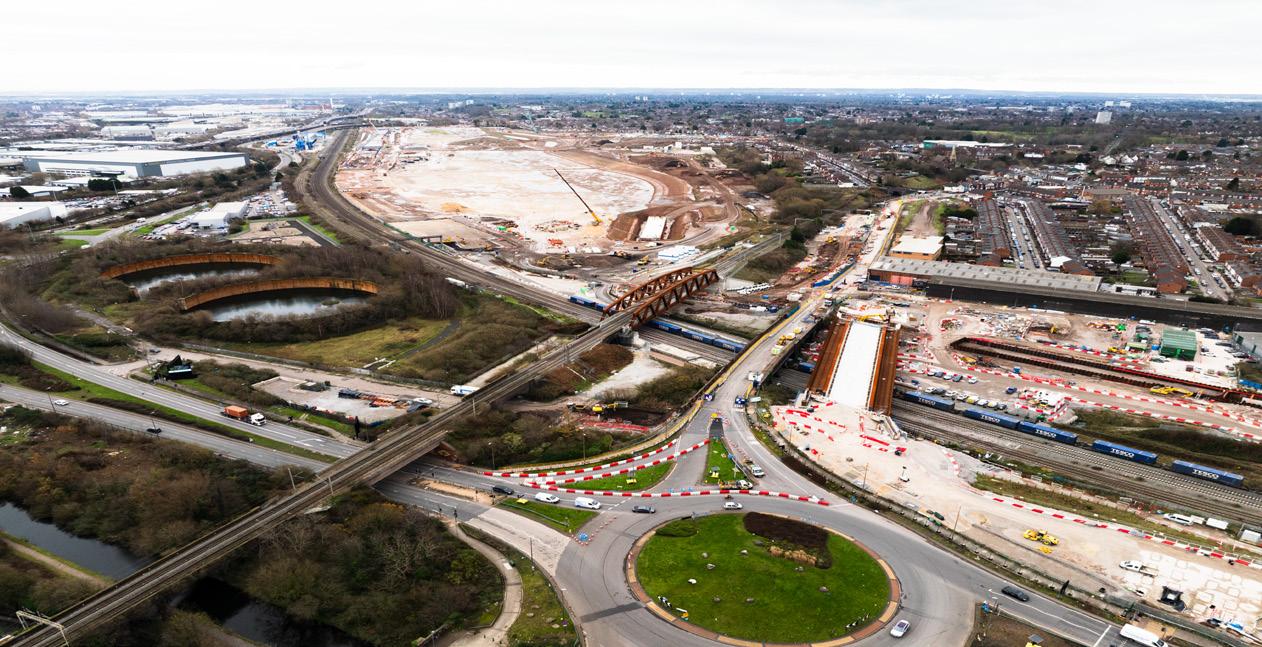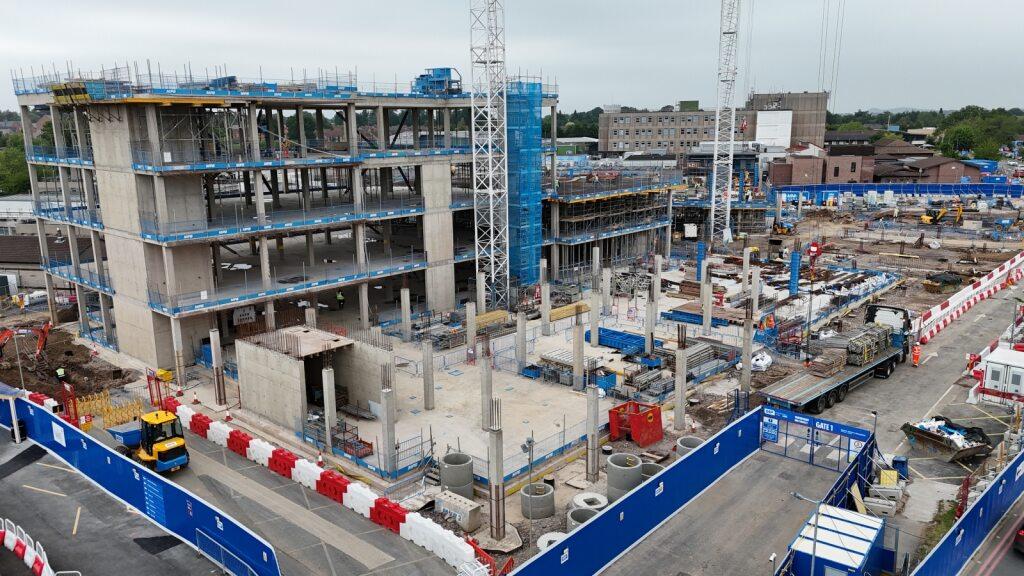

Building
Britain

AI RULES
Harnessing digital tools for good
MAJOR WINS
Key contracts for Irish firms
INDUSTRY VIEW
Optimism in forecasts

Proudly building Britain for 56 years



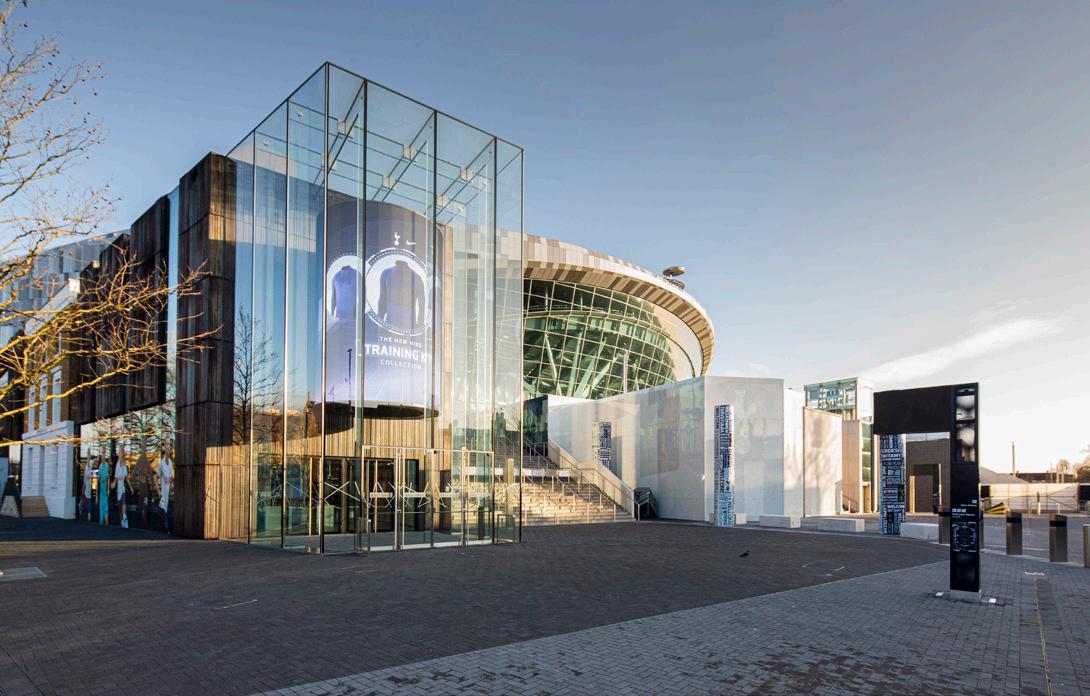
Building



Pages
Modern methods take over
THE digital transformation of the construction industry continues at pace.
Artificial intelligence is transforming all sectors across Britain and the cutting-edge technology, which enables computers and machines to simulate human learning, comprehension, problem solving and decision making, is bringing huge benefits to firms and their customers alike
Construction may be in the early adoption stages, but it is embracing the change.
There are AI tools in operation across many firms already which are having a major impact in terms of site safety and employee welfare but there is much more to come.
The team at Laing O’Rourke believe such new technology has the potential to revolutionise the sector.
“The construction industry stands at an unprecedented junction of opportunity for achieving step-change productivity improvements,” Dr Rowan Braham, one of the firm’s AI leads, explains.
“Our sector has demonstrated strong interest in exploring these possibilities,
and it’s at the cusp of understanding how emerging technologies, such as artificial intelligence, can help us transform the way we build.”
There is similar optimism at FM Conway, where AI is having a tangible impact in improving the safety of its workforce.
And Kevin Stevens, FM Conway’s Safety, Health, Environment and Quality Director, expects more good to come of it.
“The potential for digital transformation in construction is huge – limited only by our imagination of how best to implement it,” he says.
“The more we refine the application of AI in real-world settings, the better the outcomes will be.
“Now is the time to understand, engage and be part of the exciting change that is ahead of us.”
And that sentiment is key.
What is needed now is for the industry and the firms that work within it to prepare for what’s ahead.
According to Prime Minister Keir Starmer, the way things work in Britain will change dramatically over the next decade.
So it’s time to get ready for the change and prepare to implement these new ways of working.
And that is a message that is being delivered from the ground up.
With an ongoing skills crisis across Britain, modern methods of construction are being prioritised within training establishments across the country, to ensure the next generation of workers are at the top of their game in a constantly changing construction landscape.
There are new ways of working, new goals to achieve and new products which are out there ready to make things easier.
Times they are a-changing, but there is plenty to get excited about in what’s to come.
Reporting:

FIONA AUDLEY Editor
MAJOR WINS Key contracts for Irish firms
Harnessing digital tools for good INDUSTRY VIEW Optimism in forecasts
New digital tools are bringing benefits to the construction industry
MILESTONES AND MAJOR CONTRACTS
Irish firms continue to claim their place at the forefront of projects giving Britain’s infrastructure an overhaul
DESPITE a rocky start to the year in terms of overall construction output across Britain, the industry is optimistic for the remainder of 2025 and beyond.
According to recent data, compiled by the S&P Global Market Intelligence organisation, construction firms are “optimistic on balance about their prospects for the next 12 months” and there are plenty of contracts continuing and due to begin that would support that claim.
Among them are many Irish firms who continue to win those all-important jobs and complete projects of all sizes across Britain.
Here are some of the highlights of the year gone by and the contracts to watch in the months ahead…
Green light for Murphys railway
Plans to deliver a new £32m train station in Greater Manchester have reached a milestone moment this year.
Wigan Council has given the green light to the planning application for the new Golborne Station and Transport for Greater Manchester (TfGM) have appointed the local branch of Murphys to design it.
“With offices in Stonecross and Golborne, we were
particularly delighted to be appointed the first phase of this project alongside our valued supply chain including design partner WSP, to greatly improve transport links in the local area for the benefit of the surrounding communities,”
Chris Cayton, Transportation Managing Director at Murphy, said.
“As a company, Murphy is focused on improving life by delivering world-class infrastructure and this project will do just that.”
Greater Manchester has ambitious plans to bring eight commuter rail lines into the Bee Network by 2028.
The new station – which will
reconnect Golborne to the railway for the first time in more than 60 years – is part of the city-region’s wider plans to improve connectivity for communities as part of the first fully-integrated transport system outside London.
Planning approval follows hot on the heels of the government giving the go-ahead to the station’s outline business case in January, which set out the transformational benefits it will bring to the area as part of the Bee Network.
It means TfGM, Greater Manchester Combined Authority and Wigan Council, working with Government, will now develop a full business
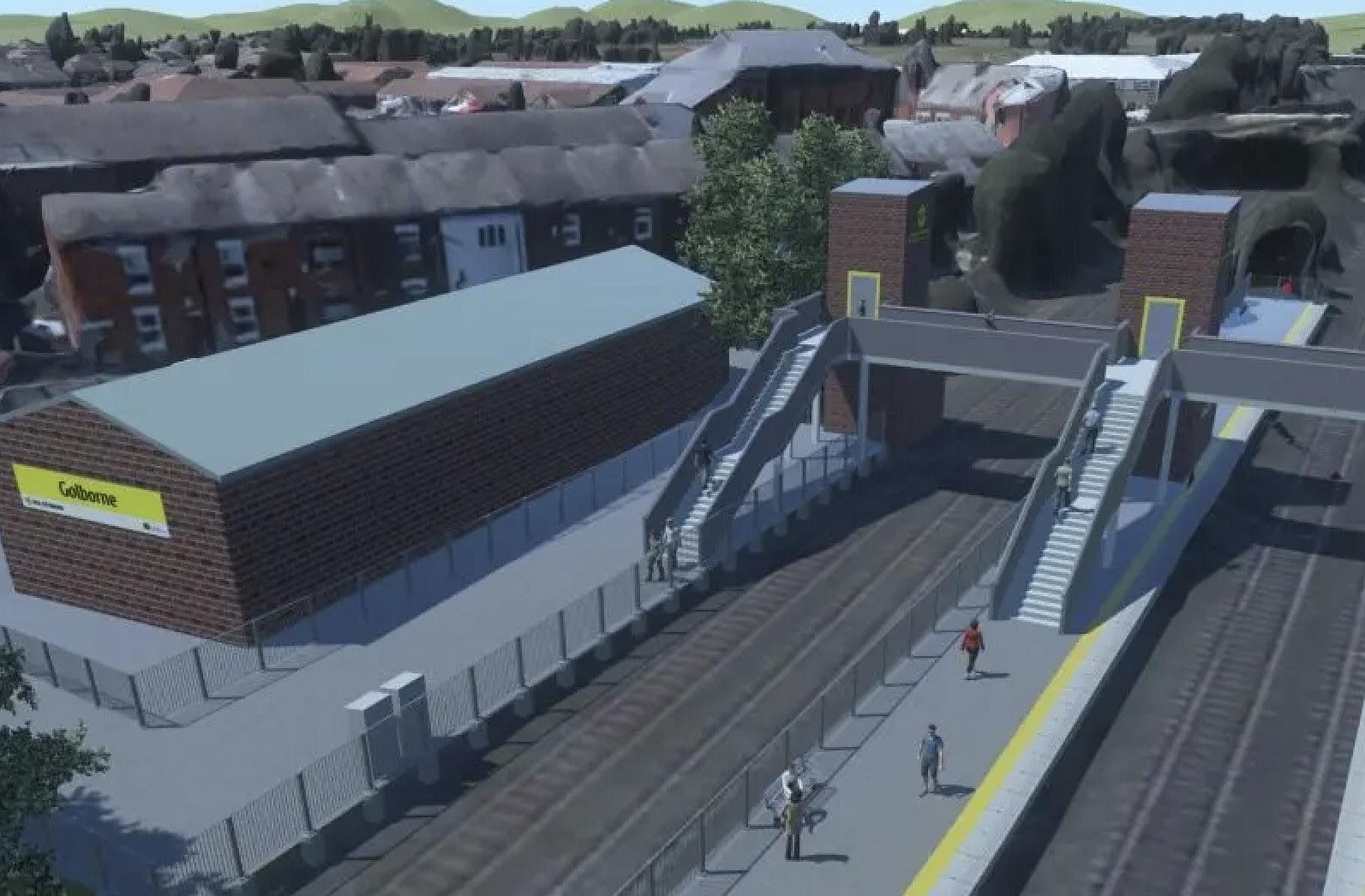
case and the detailed final station designs by Murphys this year.
Subject to approval from government, work is then expected to begin on the station in 2026 with the first trains hoped to stop there in 2027.
“This is a significant moment for Greater Manchester, with the approval of the planning application for Golborne station bringing us closer to reconnecting Golborne to the railway network for the first time in more than 60 years,” Mayor of Greater Manchester, Andy Burnham, said.
“Local residents have campaigned tirelessly for the restoration of rail services to Golborne,” he added.
“This planning approval is a victory for the community and a step towards realising our shared vision for better connectivity, easing congestion on local roads, reducing carbon emissions and supporting economic growth.
“We are committed to moving forward at pace with this project and bringing rail into the Bee Network – making it easier to get around the city-region.
“To have such a respected partner like Murphy on board to take the station through
detailed design is a fantastic result, and we can then move swiftly through to construction.
“With roots in the community, they understand how better connections will open up access to skilled jobs and opportunities across the city-region while making Golborne an even greater place to live and work.”
Golborne currently has no direct bus, train or tram services to Manchester, so train services from the new station would reduce journey times into Manchester city centre by up to 30 minutes.
A public consultation in 2024 showed high levels of support for the station proposals, and a planning application was submitted to Wigan Council last November.
The station includes plans for a new accessible two-platform rail station including step-free access throughout, a new hourly service between Wigan and Manchester Victoria and onwards to Stalybridge, an improved town centre car park, and new walking and cycling links to the town centre.
New chapter for FM Conway
January saw the acquisition of the London-Irish firm FM Conway by French construction
group Vinci.
Founded by Co. Tyrone native Francis (Frank) Conway in 1961, FM Conway now joins the Vinci Construction network, where it will “support the further growth of the company and bring additional firepower to its already successful business model, with a clear focus on innovation and sustainability” the organisation said.
With a turnover of £580m and more than 2,000 employees, FM Conway delivers essential maintenance and construction services across transportation, the built environment and public realm.
In more recent years the business has been a pioneer in sustainable construction through its advanced circular economy model, and in particular the use of high recycled asphalt on the local and strategic road networks.
It will continue to operate as a standalone business while under the ownership of Vinci, but it will benefit from the wider group support and resources.
On completion of the agreement in January, Joanne Conway has stepped away from the company and longstanding board member, Andrew Hansen, will oversee the next phase of FM Conway’s evolution
and growth within Vinci.
Mr Hansen joined the business in 1998 and becomes FM Conway Managing Director, and an EXCOM member of the UK division of the Vinci Construction group.
Mark Goldsworthy remains as Chief Financial Officer of FM Conway while joining the board of the firm will be Xavier Lansade and Scott Wardrop.
“This is an exciting new chapter in FM Conway’s story, opening up fantastic opportunities for how we deliver for our clients and for communities,” Mr Hansen said.
“We’ve always been a company that has pushed boundaries and embraced new opportunities.
“Over the past 27 years, I’ve had the pleasure of seeing firsthand what this business can accomplish.
“Now with the additional firepower of Vinci Construction behind us, I’ve no doubt that our people will continue to achieve great things. The future is very bright.”
Scott Wardrop, who is chief executive of Vinci Construction in the UK, said he was “very pleased to welcome the FM Conway team to Vinci”.
“I have known the family and senior team for a long time, respected the culture, the
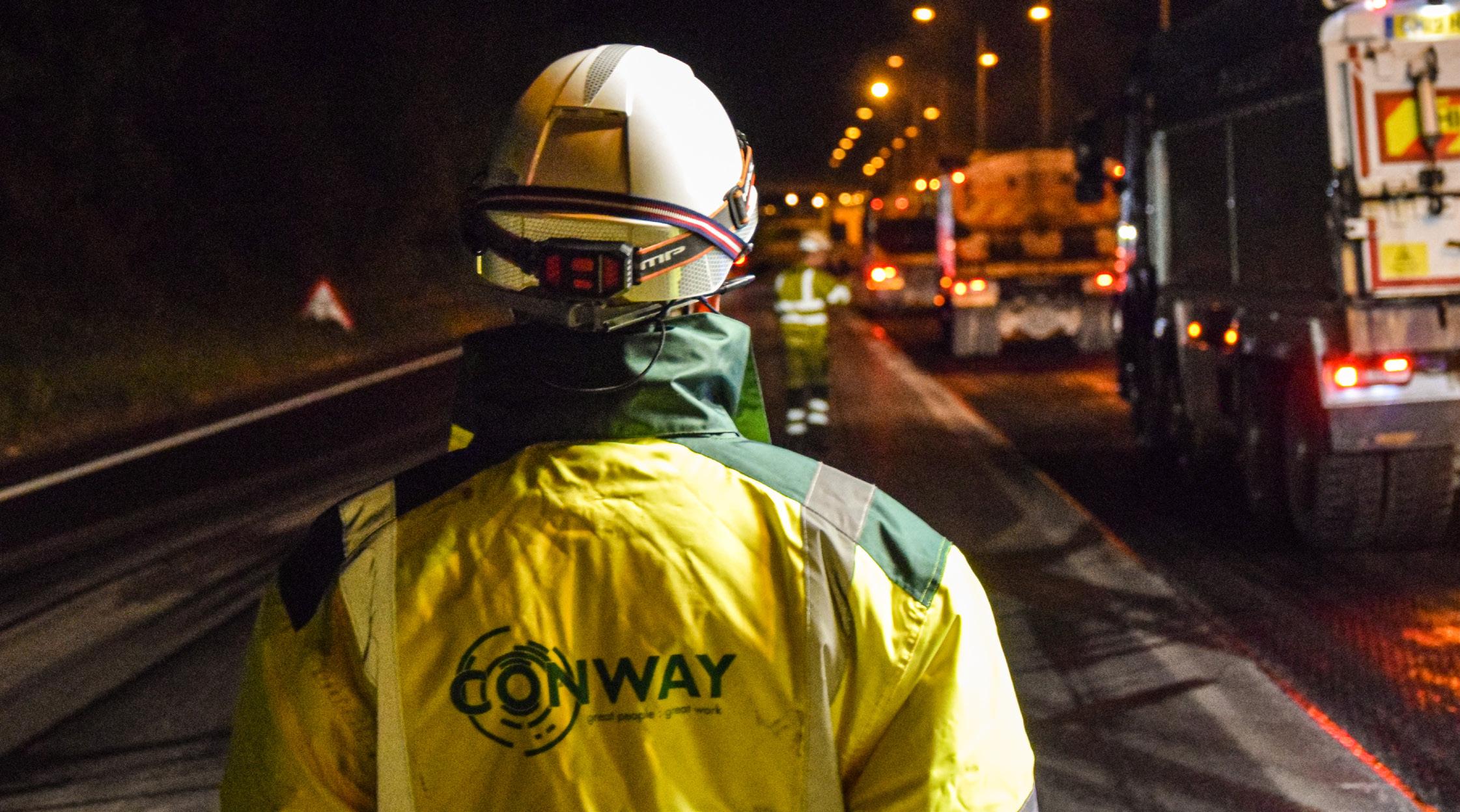
innovation and professionalism, which complements the businesses of Vinci Construction,” he explained.
“I know we will learn from each other, and firmly believe that successful and sustainable infrastructure services businesses must have knowledge of their whole supply chain – FM Conway strengthens our capability.”
Ballymore plans greener future for Camden
The team at Ballymore Group have been out and about in North London this year to engage with local residents on a new project that is set to rejuvenate the area.
The Irish-founded firm has been appointed to deliver the Camley Street project in partnership with science and tech developer and operator Lateral and Camden Council.
Through the project they will create a new, greener neighbourhood in Camden with new public open spaces and improved biodiversity.
It will see around 350 new, energy-efficient homes be delivered, more than half of which will be “genuinely affordable”, along with some 200,000 sq ft of KnowledgeQuarter-led commercial space,
including new shops and cafes.
It will also provide improved pedestrian and cycle routes to Kings Cross and Camden Town and creative workspace to support start-ups and SMEs.

At the start of the year locals were invited to meet with members of the project team for the first time, to see the plans for themselves.
Children’s activities on the day focused on STEAM, in line with the vision for the new neighbourhood to bring inspirational science and tech-based learning to the existing and new community.
“With our partners, we are delighted to have launched our engagement process and are looking forward to evolving our plans for the Camley Street site in close dialogue with the local community,” Nicola ZechBehrens of Ballymore explains.
“Guided by the vision that was co-created by local residents and Camden Council
over the last few years, we’re developing that into a detailed plan to provide homes and jobs in a green, safe neighbourhood.
“By listening and collaborating, we aim to create a neighbourhood that delivers real benefits, from new jobs and training opportunities to enhanced public spaces.”
The engagement activity continued with a community storytelling project that will offer paid opportunities for local young people to document life around Camley Street through filmmaking, videography, photography, and archiving.
A detailed planning application for the Camley Street project is set to be submitted to the local council
this summer.
Laing O’Rourke wins major science facility contract
A new world-leading science and research facility is set to be built in Oxford.
The Ellison Institute of Technology, Oxford will bring together scientists, technologists, policy makers, economists and entrepreneurs to bring scientific discovery to real-world solutions.
Plans for the state-of-the-art facility reached a milestone earlier this year when Laing O’Rourke were awarded the main contract to deliver the site.

The contract win builds on the early works which Laing began in 2022 under a preconstruction services agreement and marks the company’s third live project in the city. The firm is already working on Oxford North phase 1a, a new innovation district including laboratory buildings, and the Stephen A. Schwarzman Centre for the Humanities.
The firm described their contract with the Ellison Institute of Technology as an “important project” within one their six “priority sectors in the UK”, namely healthcare, nuclear and green energy, rail, defence, science and research, and data centres.
It is now part of the

Laing O’Rourke is building a new research facility in Oxford
Ballymore has been liaising with locals on its Camden project
•
•
•
•




company’s global record order book of £10.8bn.
“We have focused our efforts on securing work in our six priority sectors to de-risk our portfolio and achieve long-term sustainable growth,” Laing O’Rourke’s Clients & Markets Director, John O’Connor, said.
“We are delighted to partner with the Ellison Institute of Technology to deliver this critical science and research facility,” he added.
Laing O’Rourke’s Delivery Director, Martin Staehr, said he was “proud” of the firm’s teams “who have pulled together and worked tirelessly to achieve another major milestone on this unique project”.
“The Ellison Institute of Technology, Oxford aligns perfectly with our business purpose to push the boundaries of what’s possible, in service of humanity,” he added.
Liverpool’s highways will get a Sisk upgrade
Sisk is one of eight contractors who have been successful in
winning a place on a lucrative highways project in Liverpool.
Liverpool City Council is undertaking a significant programme to upgrade and modernise the city’s highways network and has selected a number of approved suppliers to carry out the project.
The Irish-founded construction firm John Sisk & Son, which is headquartered in Dublin but has bases across the UK, has won a place on Lot 2: Projects for over £1.5M.
“The framework agreement will operate as a multi-supplier contract, enabling the City Council to establish long-term partnerships with vetted contractors,” a Council spokespers confirmed.
“This structure will streamline the procurement process for planned highways works, such as highways infrastructure improvements and re-surfacing, active travel schemes and sustainable transport provision, traffic signal junctions and infrastructure, and bridge upgrades.”
Under the Council’s City Plan and 2023 Transport Plan any upgrade to the city’s roads network must prioritise accessibility, active travel, and sustainable transport solutions.
The Highways Planned Works Framework is designed to support the delivery of projects that align with these objectives, while supporting the Council’s vision for a future where walking and cycling are also prioritised.
“Sisk Infrastructure is delighted to win a place on Lot 2 of the Liverpool City Council - Highways Planned Works Framework,” Alan Rodger, MD at Sisk Infrastructure, said.
“Having recently completed the Isle of Man Ferry Terminal, the city is seeing tangible investment in large infrastructure programmes,” he added.
“We have a strong presence and capability of supply chain partners in Liverpool and the North-West and are looking forward to helping deliver improvements through the Framework that will benefit the region.”
History-making at Lynch Plant Hire
A new chapter was recently written into the history books at Lynch Plant Hire with the opening of their first depot in the West Midlands.
The brand-new, purpose-built depot in Birmingham is designed to be state-of-the-art and a facility which represents more than just machinery – “it’s a hub of innovation, sustainability, and opportunity”, the firm explains.
“With a £5m investment, this new depot symbolises our strong commitment to the region,” the Irish-founded firm added.
“Designed to support major infrastructure projects, it will also create new jobs, bringing local value and growth to the community.
“We’re proud to be making a real impact in the West Midlands.”
One of the standout features of the new depot is a dedicated

Liverpool’s highways are getting an upgrade

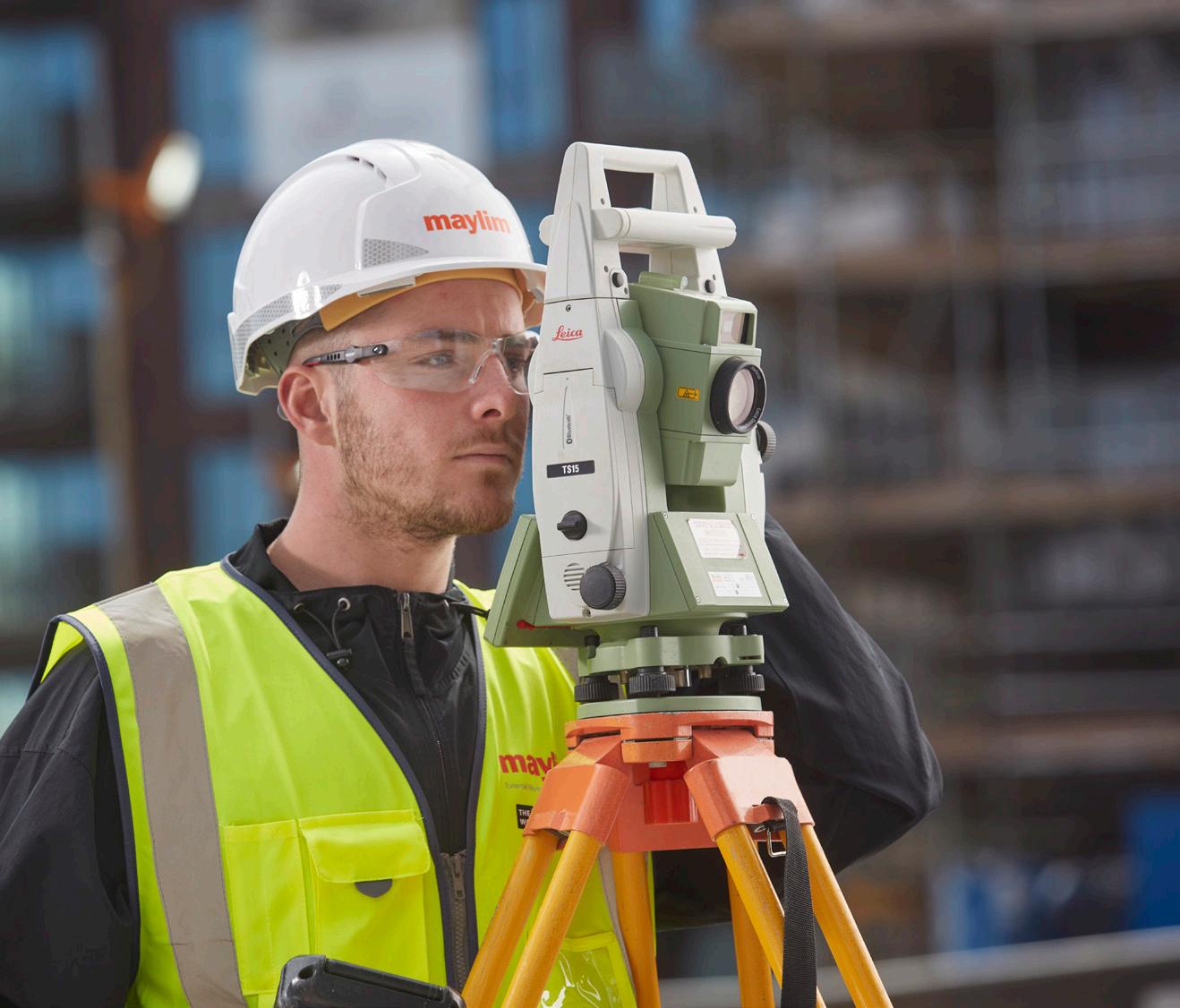







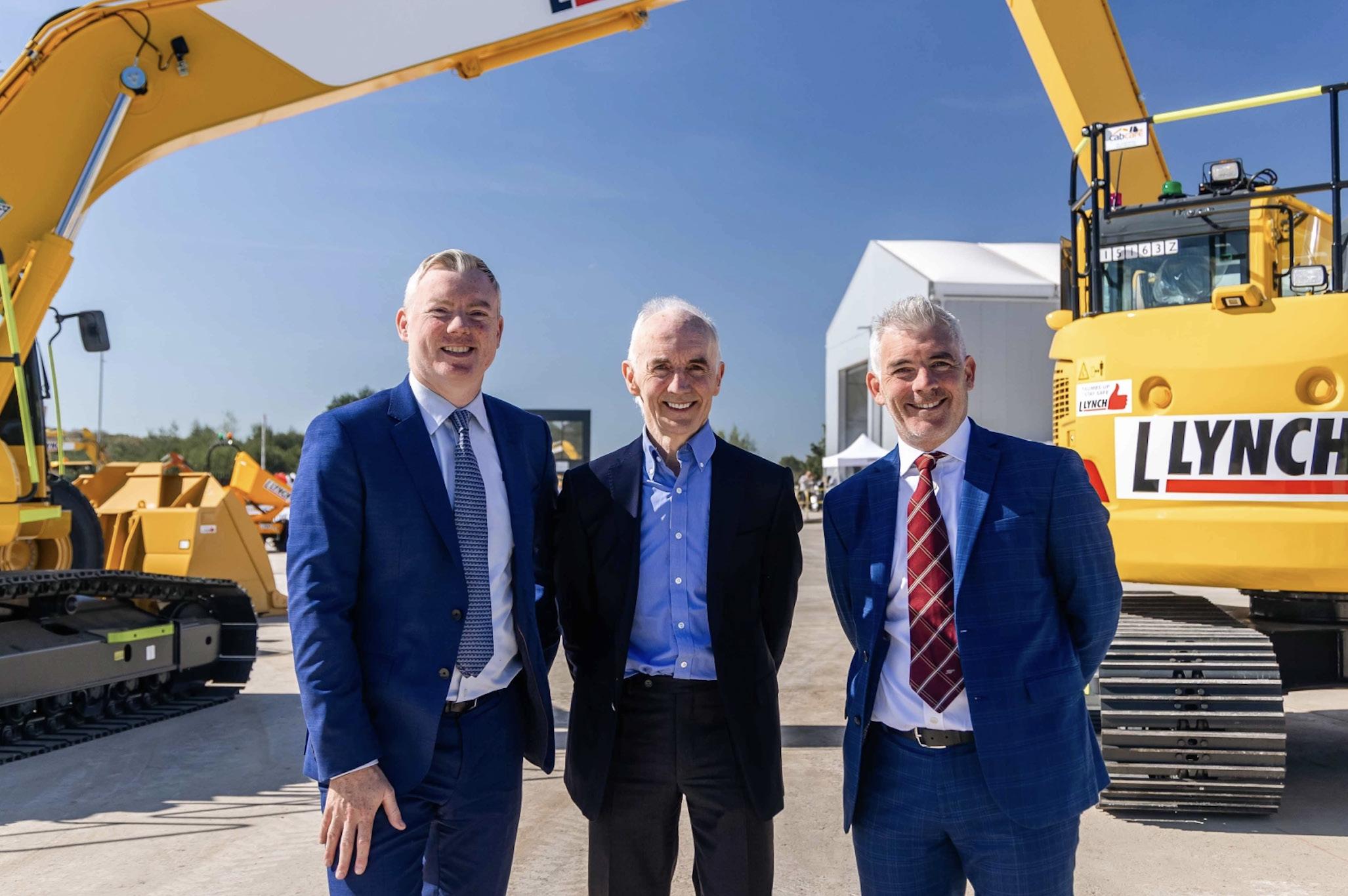
training area.
“This space is vital for our Skills, Education & Employment (SEE) commitment, where we engage with new entrants into the construction industry and help bridge the growing skills gap,” the firm confirmed.
“By providing hands-on training, we ensure we equip new talent with the knowledge and confidence to excel on-site.”
The opening brings their total number of offices across the UK to eight.
Founded by Irishman Liam Lynch in North London in 1977, the firm continues to grow and excel within the construction industry.
“This new facility is an exciting step forward for Lynch - it’s a key part of our journey towards supporting sustainable practices and building a stronger future,” the firm states.
In terms of their offering, they added: “It’s all about getting it right the first timefor our employees and our customers, and we’re proud to be at the forefront of our industry, helping our customers
build Britain’s infrastructure.”
Pivotal moment for Ecocem
Low-carbon concrete manufacturer Ecocem marked a pivotal moment in its journey this year.
The Dublin-headquartered firm successfully completed the construction phase of its low-carbon concrete demonstrator project at Wembley Park in north London.
The milestone marked a key moment in their bid to accelerate the decarbonisation of the construction industry.
The demonstrator project was based at NE02/NE03, where Sisk has been working on the redevelopment of Wembley Park for its long-term client, Quintain for the past 20 years.
Sisk successfully tested Ecocem’s low-carbon concrete at its project site in London, with the initial test results demonstrating over 70 per cent of carbon savings compared to standard concrete.
The project received £500,000 in funding from Innovate UK as part of its
Contracts for Innovation to pioneer the use of ACT, Ecocem’s low-carbon concrete technology in a structure, which is the first of its kind.
John Reddy, Director of Ecocem’s Concrete Technology Deployment, said the project was “a significant milestone”.
“The project used a range of different construction methodologies and concrete mixes all based on ACT and experience during the construction phase indicates that it behaves and performs as you would expect concrete to – with one significant difference – it can deliver a carbon saving of over 70 per cent.”
He added: “Ecocem has been testing and trialling ACT, our low-carbon cement technology for the last 12 months in a range of onsite applications and early test results on this demonstrator are in line with our previous experience.
“For each application it delivers the required performance in terms of workability, durability, and early age strength.
“We need now to change concrete standards so that
low-carbon solutions like ACT can be adopted for construction use and deliver significant carbon reduction at speed.”
Ecocem recently held a day at the Wembley Park site to reflect on the project and invited the many partners involved to join them.
“The day provided an opportunity to showcase the two-storey demonstrator structure built using ACT, Ecocem’s advanced low-carbon cement technology,” the firm explained.
“This structure incorporates pre-cast stairs, columns, walls, and in-situ slabs and rising elements, all constructed with ACT cement technology using a range of construction methodologies.”
The event allowed the groundbreaking Irish firm to further showcase the benefits of using their low-carbon cement.
“The most remarkable thing about concrete made with ACT cement is how unremarkable it is,” a spokesperson for Ecocem explained.
“It works. It performs like any
A new branch is an ‘exciting step forward’ for Lynch Plant Hire

A LEGACY OF CONSTRUCTION EXCELLENCE
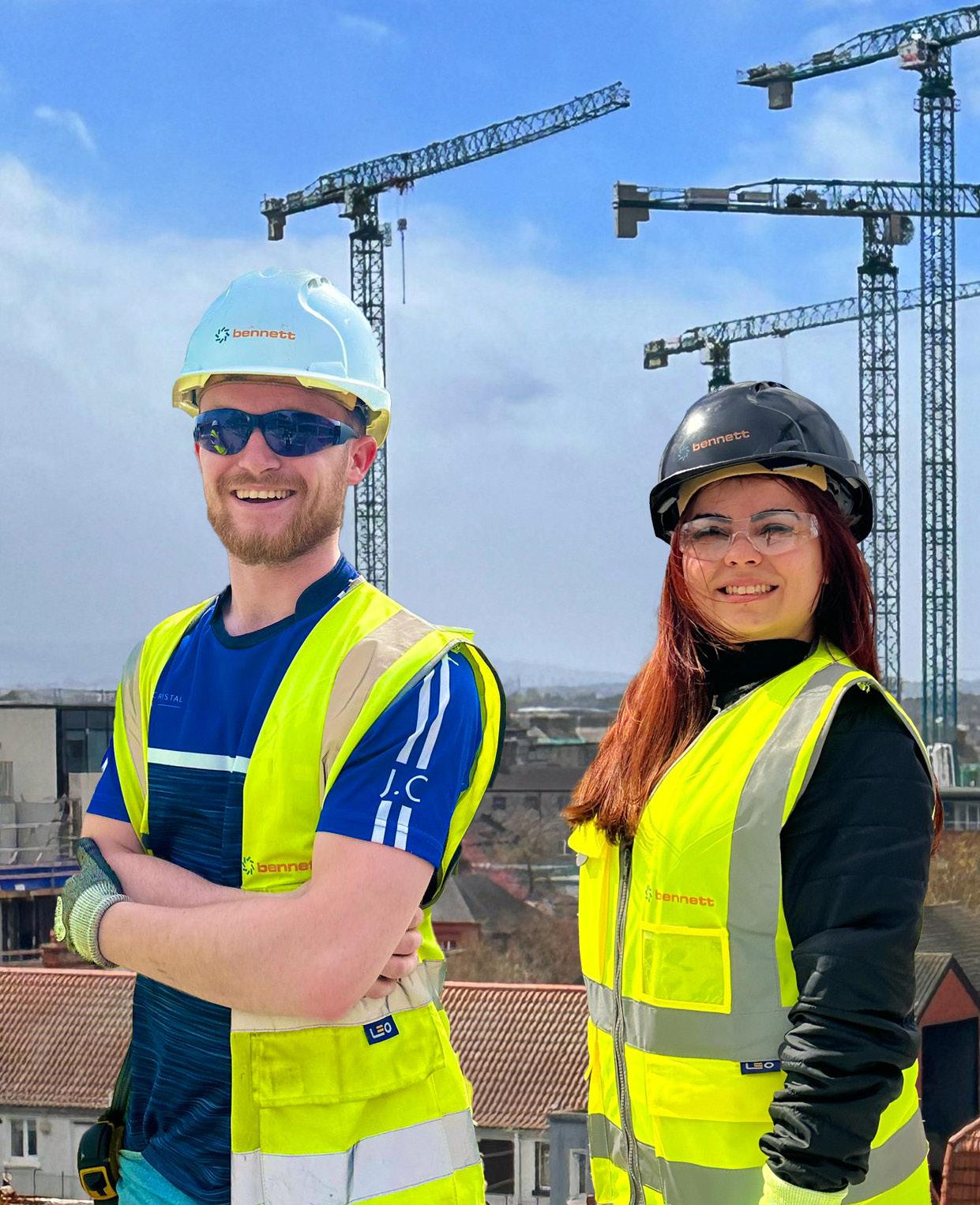

good concrete should, doing exactly what’s expected - but with one vital difference: it carries a fraction of the carbon footprint.
“For our partners on this project, Sisk and Quintain, the path forward is clear.
“We now need to work together to address the remaining challenge: standards and regulations need to be amended to enable the insurability and wider adoption of low-carbon technologies like ACT.
“This project demonstrates that barriers to adoption of low-carbon cement technologies are no longer technical – they are regulatory.”
Looking to the future, Ecocem are positive they will succeed in their mission to decarbonise the industry.
“The successful delivery of the Wembley Park demonstrator is not only a landmark moment for our ACT technology, it also marks the
start of the next phase,” they said. “With construction of our first ACT production facility in Dunkirk underway, scheduled to start production in 2026 with an initial capacity for 300,000 tonnes a year, we are now on track to produce at scale.
“The priority now is pushing for the industry-wide changes needed to make low-carbon concrete the norm.”
Imperial College contract continues for Careys
Careys is the principal contractor for the ongoing redevelopment of Imperial College London.
The firm, founded in London in 1969 by Irish brothers John, Tom and Pat Carey, continues to be family-run today, although its reach now stretches across the country.
Currently the firm is at the heart of the major transformation of the college’s
campus in London’s White City area.
Part of a designated Opportunity Area within Mayor of London Sadiq Khan’s London Plan, the 23-acre campus is leading large-scale change across the neighbourhood, providing new jobs, homes, facilities and infrastructure.
“White City Campus is much more than an academic hub,” the college explains.
“It brings together research, business, and the local community in a new model for university-led development — one designed to spark innovation, foster collaboration and deliver long-term benefits locally and globally.”
White City Campus is being redesigned as a place for connection and collaboration - not just for those who work and study there, but members of the wider community too, and Careys is leading that redevelopment.
Recently the firm completed
the demolition of a bridge over Transport for London’s Central line, which had been in situ for over 70 years.
The “intricate task” took “months of detailed planning”, a Careys spokesperson confirmed, before their team started the breaking works whilst working over an operational tube line.
Then, during a series of nighttime closures of the Central line, the steel beams supporting the bridge - which each weighed up to 30 tonnes - were expertly removed by the firm with the help of a specialist lifting team and mobile crane.
Once finished, White City Campus will be an “open, accessible place that prioritises people, with welcoming entrances, pedestrian and bike-friendly routes and public spaces that connect seamlessly with the surrounding area and which brings students, staff, residents and visitors together,” the college says.
The two-storey demonstrator structure built using Ecocem’s ACT technology



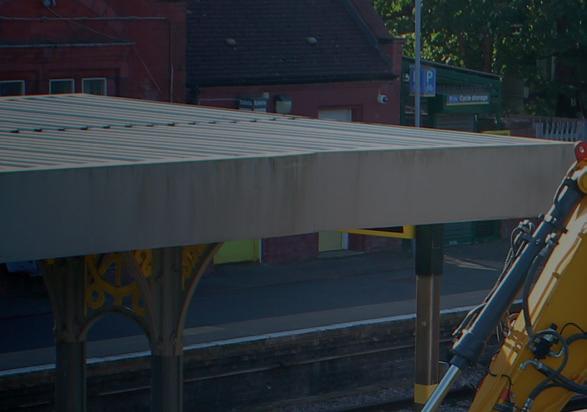
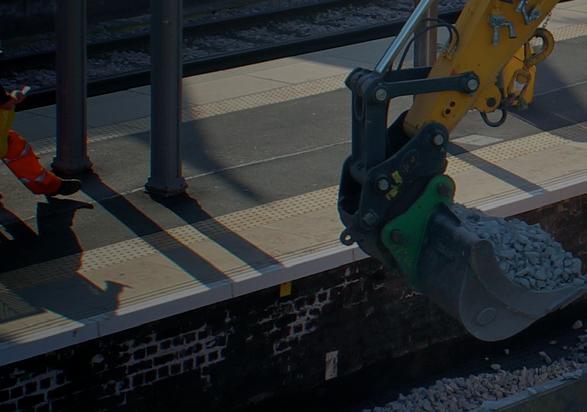
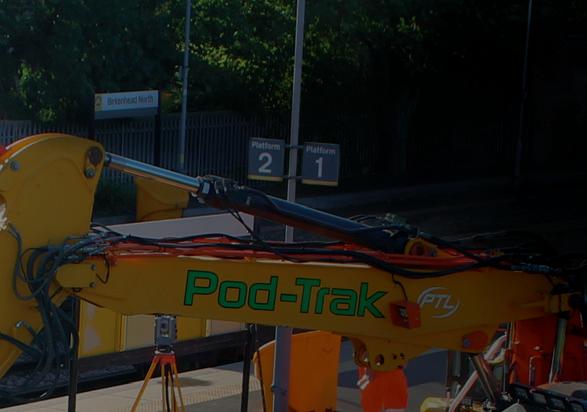
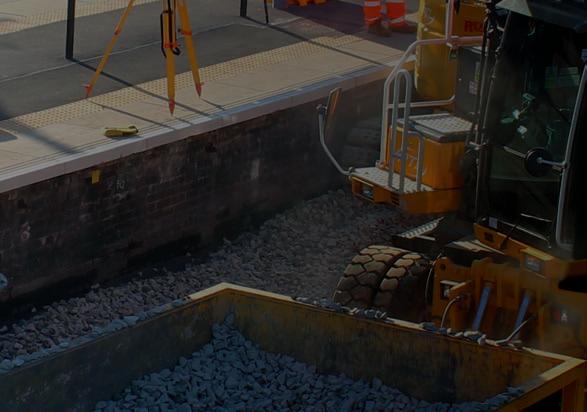


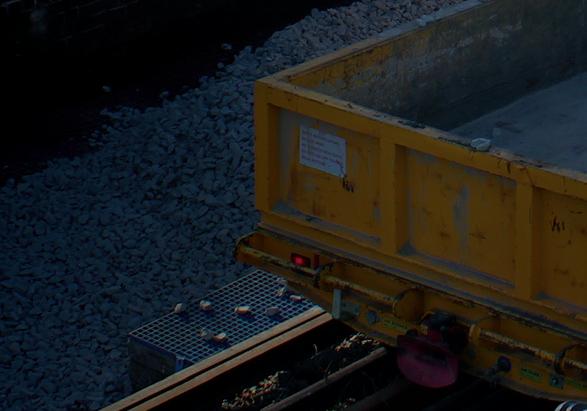
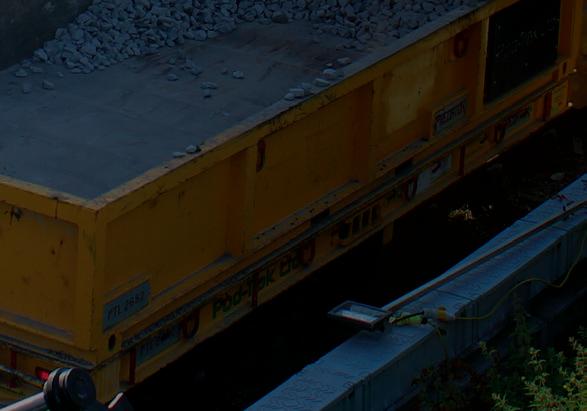























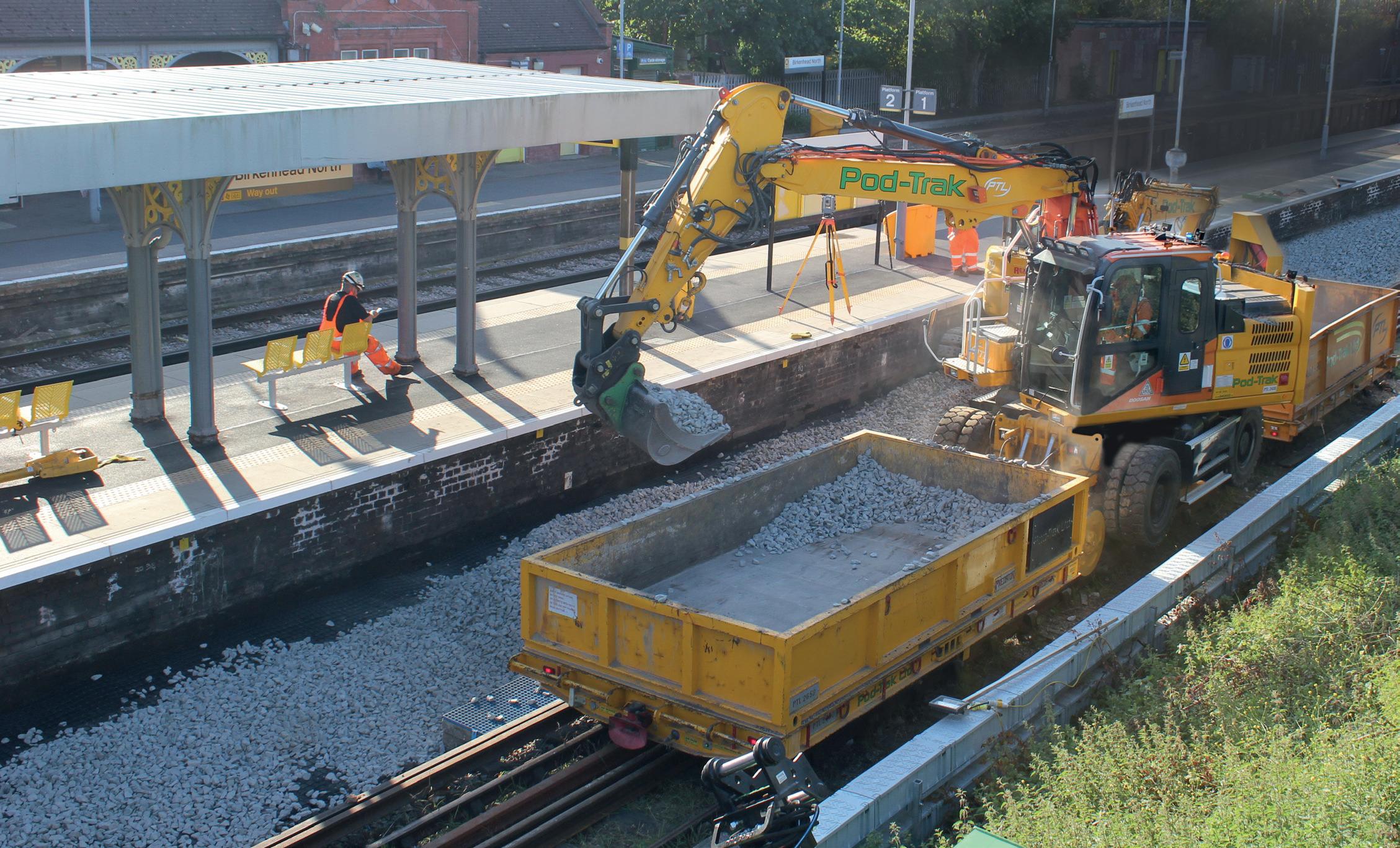





EMBRACING AI

Technological advances and artificial intelligence offer valuable new tools for the construction sector, FIONA AUDLEY reports…

ARTIFICIAL intelligence is expected to transform the way things work in Britain over the next decade.
There is no doubt that the technology, which enables computers and machines to simulate human learning, comprehension, problem solving and decision making, will revolutionise industries in the years ahead.
It is already doing so, in fact.
AI assistance is now commonplace in tools used by firms across all sectors, from IT to health and retail to transportation, legal and financial services and even in the construction sector.
At the very base level the use of AI for mundane automated tasks is boosting productivity, reducing human workloads and freeing up employees to spend their time on more complex or creative projects.
For example, tools like chatbots and AI-powered assistants are transforming customer service interactions, offering new and streamlined ways for all types of businesses to interact with their customers.
Elsewhere the use of AI in data analysis has already proved hugely successful, as it can quickly process large
volumes of current and historical data, drawing conclusions, capturing insights, and forecasting future trends or behaviours, without the need for human intervention.
Even in the construction sector, which is in the early stage of AI adoption and where firms are traditionally more reluctant to embrace change, these new tech tools are having an impact.

Laing O’Rourke, the Irishfounded global construction firm, is fully embracing the arrival of AI, claiming it has the potential to revolutionise the sector.
“Productivity is one of the central challenges for innovation in construction today,” Dr Rowan Braham, Laing O’Rourke’s Predictive Analytics and AI Lead in Australia, said.
“While our industry has fundamentally transformed operating paradigms and impact through remarkable progress in safety protocols,
environmental stewardship, and social responsibility, improving productivity has remained persistently challenging.
“This productivity plateau has had to be overcompensated through increased labour and capital inputs, with consequences such as increased construction costs and, in some cases, project delays,” he added.
“The ability to build our environment is a core capability of our society, directly impacting the quality of our infrastructure and ways of
living, so improving productivity through innovation is of foundational importance.
“The trajectory to improve productivity appears promising,” Dr Braham suggests.
“The construction industry stands at an unprecedented junction of opportunity for achieving step-change productivity improvements.
“Our sector has demonstrated strong interest in exploring these possibilities, and it’s at the cusp of understanding how emerging technologies, such as Artificial

New tech tools could have a huge impact
Intelligence (AI), can help us transform the way we build.
“With AI, we can address some of the core issues of our time and ignite a transformational change in the construction sector.”
Laing O’Rourke sees many benefits of using new AI tools within existing construction processes.
“AI development has recently accelerated,” Dr Braham says, “and several AI-based tools can now demonstrate productivity improvements in all parts of the modern construction process.

all roles from project engineer to bid leader, is filled with such tasks.
“AI, while most broadly known today through technologies such as Large Language Models (LLMs) and generative AI, represents a broad suite of statistical and computational methods through which algorithms can understand something about the world and the humans living in it,” he adds.
Dr Braham believes productivity improvement from AI for the construction industry will come from two directions. Firstly, its ability to shoulder the “burden of the mundane, routine and ordinary”, as well as its “ability to see through complexity and shed light on implications and insights that were previously hidden to us”.
“Modern construction is characterised by an extensive and complex process managed across numerous interfaces, and workers at all levels end up spending significant amounts of their time managing what can be called ‘foundational’ tasks,” he explains.
“These are tasks that are important and must be executed well but are not the things that will differentiate a project.
“Routine correspondence, repetitive administration tasks, cross-checking data, filling forms; much of the time of the modern construction worker, in
“Each minute spent on a foundational task is a minute that cannot be spent on a value adding task – finding creative solutions, building connections and finding opportunities to drive improvement.
“Early research suggests that AI can substantively shift the balance between value-adding and foundational tasks in construction, with reductions in time of 65 per cent spent on foundational tasks being demonstrated by some companies.
“By automating routine administrative work, AI liberates human potential, allowing skilled professionals to focus on creative problemsolving and innovation.
“For example, Large Language Models can sift through thousands of pages of regulations, contracts, and specifications in minutes, distilling key information and flagging potential compliance issues.
“This task, which might consume days or weeks of a human expert’s time, can be significantly reduced, and allow that expert to focus on the implications and broader context that output sits within.”
He adds: “The second transformative aspect of AI in construction is its unparalleled ability to process and
synthesize complex, multidimensional data.
“The modern construction process generates a deluge of information, from intricate digital twin models and real-time IoT sensor data to complex financial projections and multifaceted risk assessments.
“AI systems can ingest this vast ocean of data, discover the patterns and processes that lie dormant under the surface, and then dredge these up in ways that are actionable and intuitive to human decision-makers.
“Here AI enables and empowers humans to make better informed decisions in the face of complexity, working on the value-adding refinement.
“Accountability and ownership are not taken away, rather the human-in-the-loop is empowered and augmented and is better equipped to make complex and challenging decisions.
“This capability enables a new paradigm of data-driven decision-making across the entire construction lifecycle.”
The benefits of AI to the construction industry are presenting themselves in other ways too.
An AI-powered robotic dog is among a raft of new processes which are transforming employee safety at FM Conway.
The Irish-founded firm, headquartered in London, has been trialling the robot
quadruped, which is fitted with LIDAR (light detecting and ranging) technology and a 180-degree high resolution camera, on their many longterm maintenance contracts with Britain’s highway authorities.
The ‘dog’ has the ability to eliminate the need for humans to enter unsafe, confined spaces.
“At least 20 times a week one of our teams will receive a notification that there has been a partial collapse of void in the highway or footway, and they will have to be on site within two hours,” FM Conway’s Structures Director Adam Barnes explains.
“Our teams may not have a lot of information on what the structure is or how it was built and there is usually only one point of entry.”
The firm will have to assess the situation and identify the defect before deciding whether a full dimensional survey and conditional report is needed.
“At the moment that means sending a highly trained operative into a challenging environment to gather information,” Mr Barnes says.
“It could be a confined space which is dark and dirty, partially damaged or collapsed, with uneven brick or rubble.
“From a safety and risk point of view, we want to avoid sending someone into that environment if we possibly
AI has the ability to transform the way we build
can.”
The robodog being trialled by FM Conway was initially developed for search and rescue tasks, so it can fit in small, confined spaces, can walk across uneven surfaces and can collect data along the way.
It is remote controlled and can be ‘taught’ to recognise or avoid certain objects and can be fitted with attachments in order to collect samples too.
Its use in such situations, which are potentially harmful for humans, could be lifesaving.
Kevin Stevens, who is FM Conway’s Safety, Health, Environment and Quality Director, believes there are further safety benefits which AI can bring to the industry.
“The construction industry is still in the early stages of AI adoption, but we’ve already seen some tangible benefits at FM Conway,” he admits.

“One area we’re particularly excited about is how AI can enhance site safety.
“We recently upgraded our AI detection systems on plant machinery such as road rollers, which are used to compact road surfaces, to help keep our teams and the public safe.
“We can now track the movement of people near the machines and even predict patterns of movement around them to respond proactively before any incidents can occur – slowing down or stopping equipment when necessary.”
There have been benefits on the training side of things, too.
“We’ve also found that
“AI-enabled safety detection cameras have been a huge help in training people to follow the right safety procedures on site,” Mr Stevens explains.
“Since the technology was introduced, we’ve seen a significant improvement in adherence to safety rules.”
As the construction firm navigates the new AI terrain, their clients are doing the same.
“Many of our clients have embraced these innovations because they directly support their own goals around risk reduction, efficiency and compliance,” Mr Stevens explained.
“We have been taking them on the journey with us, thinking collaboratively and demonstrating how AI can reduce risk, speed up project delivery and remove barriers to success for everyone,” he added.
“The more we successfully implement AI, the more we can pass the benefits on to our clients.”
So, what challenges lie ahead for embedding AI more deeply in the construction industry?
“The sector’s natural hesitancy to change is one challenge we’ll continue to face as we transition towards more AI adoption,” Mr Stevens says.
“But the best and most effective way to address this is through education.
“This means helping people to use AI safely and ethically, ensuring it’s seen as a support tool not a replacement for human judgement and collaboration.”
He adds: “The potential for digital transformation in construction is huge – limited only by our imagination of how best to implement it.
“The more we refine the application of AI in real-world settings, the better the outcomes will be.
“Now is the time to understand, engage and be part of the exciting change that is ahead of us.”
The vast potential of AI to improve processes across British industry has not been lost on the Government either.
At the start of this year Prime Minister Keir Starmer put his full weight behind it, claiming
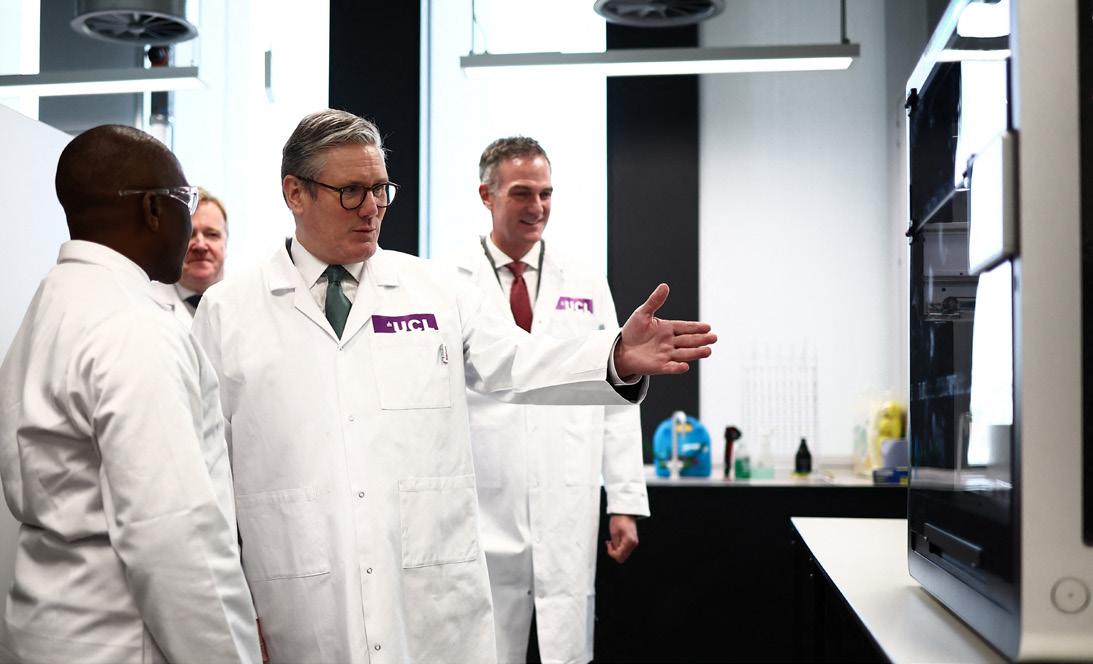
the good that can come from the use of artificial intelligence must be harnessed so that Britian can reap the rewards.
He set out an ambitious blueprint to turbocharge the use and availability of AI in this country.
“Artificial Intelligence will drive incredible change in our country,” he said.
“From teachers personalising lessons, to supporting small businesses with their recordkeeping, to speeding up planning applications, it has the potential to transform the lives of working people,” he added.
“But the AI industry needs a government that is on their side, one that won’t sit back and let opportunities slip through its fingers. And in a world of fierce competition, we cannot stand by. We must move fast and take action to win the global race.”
Unveiling details of the government’s AI Opportunities Action Plan the Prime Minister added that AI can “transform the lives of working people” over the next ten years.
“It has the potential to speed up planning consultations to get Britain building, help drive down
admin for teachers so they can get on with teaching our children, and feed AI through cameras to spot potholes and help improve roads,” he explained
“Our plan will make Britain the world leader.
“It will give the industry the foundation it needs and will turbocharge the Plan for Change.
“That means more jobs and investment in the UK, more money in people’s pockets, and transformed public services.”
While the construction sector is still in the early stages of AI adoption, new technologies are already saving the industry time, helping firms make better decisions and reducing risk.
The AI revolution is expected to bring further rewards to those firms who embrace such digital transformation.
In the meantime, the British Government’s plans to expedite the building of AI-related infrastructure across the country, such as data centres and tech hubs, will mean more contracts available for construction firms.

FM Conway’s Kevin Stevens
Prime Minister Keir Starmer is embracing the use of AI across all industries
The Government has launched an AI Action Plan
FORWARD THINKING
Industry leaders are fully behind the PM’s plans to embrace artificial intelligence
Darren Hardman , CEO, Microsoft UK:
“The scale of the British government’s ambition for AI development and adoption in the UK is exactly what’s needed to drive economic growth, transform public services and create new opportunities for all.
Maintaining the UK’s position as a global leader in AI demands innovation and investment across the public and private sectors and Microsoft is fully committed to helping make this vision a reality.”
Mike Beck, Global Chief Information Security Officer at Darktrace:
“As a home-grown AI company, we know that the UK has world-class research talent, brilliant institutions and a strong tech ecosystem.
Governments can and should move at a faster pace to help realise the benefits of rapid technological change, and we look forward to the government swiftly implementing this Plan.
This will help to turn AI from abstract opportunity to real-world benefit in offices and shop floors across the country.”
Dario Amodei, Co-Founder and CEO of Anthropic:
“The UK’s AI Opportunities Action Plan is a bold approach that could help unlock AI’s potential to solve real problems. By combining infrastructure investment with strategic planning, the UK could be among the first and fastest governments in the world to transform how services are delivered to its citizens.
We look forward to working with them to turn this vision into a reality.”
Alex Kendall, Co-Founder, Wayve: “Embodied AI in highly regulated sectors, like automated vehicles, will require international regulatory collaboration.
I’m excited to see the government use the levers at its disposal to help make the UK’s leading AI startups winners on the global stage.
We now welcome the new targeted support for international expansion for AI scale-ups, and will pursue our global growth goals with the confidence that we have the UK government’s full support.”
Chris Lehane, Chief Global Affairs Officer at OpenAI:
“From the locomotive to the Colossus
computer, the UK has a rich history of leadership in tech innovation and the research and development of AI.
The government’s AI action plan - led by the Prime Minister and Secretary Peter Kyle - recognises where AI development is headed and sets the UK on the right path to benefit from its growth.
The UK has an enormous national resource in the talent of its people, institutions and businesses which together, can leverage AI to advance the country’s national interest.”
Alison Kay, Vice President, UK and Ireland at Amazon Web Services:
“The UK government’s AI Opportunities Action Plan will play an important role in helping the UK to unlock the full potential of AI, and in doing so, boost productivity, enhance economic growth, and improve public services.
At AWS, we’ve seen first-hand the benefits that digital technologies like AI can bring, and that’s why we’ve announced plans to invest £8bn over the next five years building, operating, and maintaining data centres in the UK.
By putting close industry collaboration and public-private partnership at the heart of the government’s agenda, every citizen, community and business in every region of the UK will have the opportunity to realise the benefits of AI and thrive and grow.”
Mike Mattacola, Chief Business Officer at CoreWeave, said:
“CoreWeave’s commitment to the UK is reflected in our significant investments throughout 2024, including the establishment of our European headquarters in London. Having delivered on our commitment to have two large-scale operational data centres by the end of 2024, CoreWeave is delivering critical compute infrastructure needed to boost AI progress in the UK and adding high value jobs across the country.”
Zahra Bahrololoumi CBE, CEO, Salesforce UK and Ireland, said:
“Businesses in the UK are in a prime position to fully unlock the opportunities of AI, thanks to a strong innovation culture and risk-based laws.
That is why Salesforce chose the UK as the location of its first-ever AI Centre,
building on our commitment to invest $4bn in our UK operations to harness the transformational power of AI.
In the coming year we will see more and more businesses embrace innovative solutions such as agentic AI to tackle everyday tasks, but they need investment and expert guidance to unleash long-term value and productivity gains.”
Siobhan Wilson, Senior Vice President and UK Country Leader, Oracle, said:
“AI is helping revolutionise the way businesses and the public sector operate. It enables new ways of working that can help drive innovation and success.
The publication of the Action Plan is an important step to help continue AI adoption across the UK.
At Oracle we are providing a full set of solutions to help organisations use AI securely and efficiently, which we expect will accelerate economic prosperity and growth for our customers and the nation.”
Séamus Dunne, Managing Director at Digital Realty in the UK and Ireland:
“We’re excited to support the UK government’s ambitious plans to position the UK as a global AI powerhouse.
With its exceptional talent, robust business ecosystem, and forward-thinking government, the UK is uniquely positioned to lead in this transformative field.
We’re proud to contribute to this vision by providing the cutting-edge infrastructure that will help unlock the full potential of AI and cement the UK’s leadership on the global stage.”



OPTIMISM DESPITE INDUSTRY SLUMP
Construction projects stalled in early 2025 but firms predict better days ahead
CONSTRUCTION activity
across Britian decreased for four consecutive months at the start of the year due to business uncertainty and delayed decision making.
PMI Survey data recorded the slump across the sector, although civil engineering proved to be the weakestperforming area of construction activity in the first quarter of the year.
Commercial work also decreased for the fourth month running into April, with the pace of decline in that field accelerating to its fastest since
May 2020.
Residential work, however, showed a degree of resilience within the industry-wide decline, with the rate of contraction easing to the least marked in 2025 to date.
“Construction activity decreased for the fourth consecutive month as rising business uncertainty led to delayed decision-making on new projects,” the report explained.
“The latest survey indicated further declines in total order books and cutbacks to staffing numbers,” it adds.
The report offers some
optimism for the remainder of the year, with survey respondents admitting they expect their order books to fill up.
“Looking ahead, construction firms are optimistic on balance about their prospects for the next 12 months,” the report states.
“Around 41 per cent of the survey panel forecast a rise in output, while only 18 per cent predict a decline,” they add.
“This signalled a slight improvement in business optimism to its highest since December 2024.
“A number of firms
commented on positive expectations for residential building work, despite ongoing domestic economic headwinds and fragile client confidence.”
Tim Moore, Economics Director at S&P Global Market Intelligence, who compile the PMI data, claims firms found clients unwilling to commit to large projects, preferring to “wait and see”.
“UK construction companies have endured a bumpy ride since the start of the year as domestic economic headwinds and hesitancy among clients led to a lack of new work to replace completed contracts,”

Housebuilders expect a turnaround in workloads
he said.
“Output levels continued to slide in April, but the rate of decline eased to its slowest for three months.
“This was helped by slower reductions in residential building work and civil engineering activity.
“Commercial construction was a weak spot and lost
momentum since March.”
He added: “Output decreased at the fastest pace for nearly five years amid reports of greater risk aversion among clients and a wait-andsee approach to major spending decisions. “
But it’s not all doom and gloom for the months ahead, according to Mr Moore.
THE VIEW IN IRELAND
New projects drive employment and growth
Unlike its island neighbour, Ireland has seen a continued increase in construction activity so far in 2025.
Growth in new orders have driven increases in employment and purchasing activity across the country, according to data compiled in the AIB Ireland Construction Total Activity Index.
The report claims “companies remain optimistic regarding the yearahead outlook, despite some worries from panellists regarding the impacts of US trade policy”.
Firms that saw activity increases linked this to improving customer demand and an associated increase in new orders.
The rise in construction activity was broad, the report adds, based across the three categories covered by the data collection.
The fastest increase was in commercial activity, which expanded for the third month running in April and at a solid pace, albeit one that was softer than in the previous survey period.
Civil engineering activity, meanwhile, rose at the fastest pace
“An encouraging development was a slight improvement in business activity expectations for the year ahead,” he confirmed.
“Output growth projections improved to the highest level so far this year in April, with a number of survey respondents citing the prospect of a turnaround in workloads across the residential building segment.”
However, the construction industry slump witnessed so far this year has caused concern at the Federation of Master Builders (FMB) who claim the PMI figures should “set alarm bells ringing”.
“These figures only confirm the alarming trend which builders across the UK have been experiencing for months,”
FMB Chief Executive Brian Berry said.
“We’re seeing construction output falling at its fastest rate
in almost five years, at the heart of the pandemic, and with input cost inflation also rising fast, already fragile market confidence is likely to take yet another hit.”
He added: “With new work down sharply, particularly in the house building segment, the Government needs to take urgent action to reassure builders and consumers if they are serious about meeting their targets.
“Urgent steps are needed to diversify the housing market, and give SME builders the opportunity to step up and build the homes on the smaller sites which the major volume housebuilders can’t reach.
“We need to see greater resource given to local authority planning departments to support the small builders who stand ready to deliver the homes we need.”
since February 2022.
The slowest increase in activity was on housing projects, but growth has now been sustained in that residential category for eight months running.
With new projects getting underway, construction firms again felt the need to hire additional workers in April which saw employment rise for the second month running, and at a slightly stronger pace than in March.
The usage of sub-contractors also increased, as a result.
“The AIB Irish Construction PMI survey for April showed that the sector had a solid start to the second quarter,” AIB Senior Economist John Fahey said.
“The headline index remained above the key 50 level, consistent with a second consecutive month of an expansion in activity,” he explained.
“However, it printed at 52.4 in April, which was below its reading of 53.9 in March, indicating a slowdown in the pace of growth.”
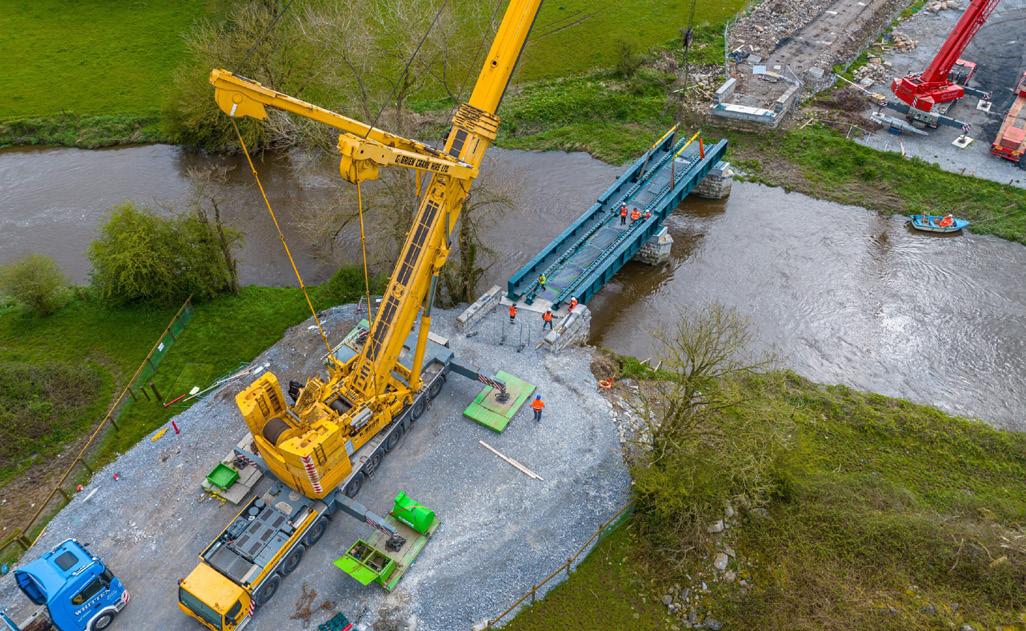
He added: “From a sectoral perspective, the improvement in activity levels remained broad-based.
“Of the three sub-sectors, commercial activity was once again the best performing, although its pace of growth moderated compared to March.
“Meanwhile, the residential sector recorded its eighth consecutive month of growth, but at a slightly slower rate versus March.
“Elsewhere, civil engineering continued to show signs of improvement, with output rising for a second month in-a-row.”
Mr Fahey reiterated the optimism felt by construction firms for the year ahead.
“Firms attributed the growth
in activity to an improvement in demand conditions,” he said.
“This was reflected in new orders expanding for a third straight month, broadly maintaining the pace of growth recorded in March.
“This backdrop of new projects saw firms continue to increase their staffing levels. Indeed, the pace of employment growth accelerated in April.
“Looking ahead, construction sector firms retained an optimistic view on the prospect of increasing activity levels over the coming 12 months.
“However, some firms did reference the potential drag on activity levels from US trade as being a source of concern.”
Construction projects are on the increase in Ireland


Kindly




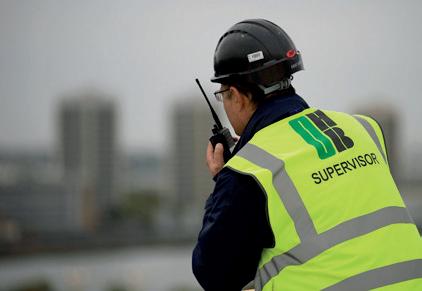


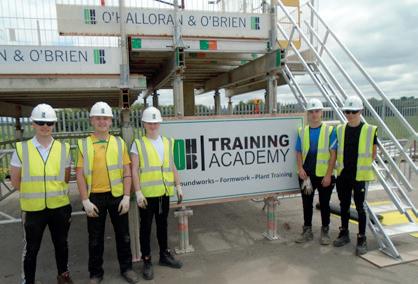

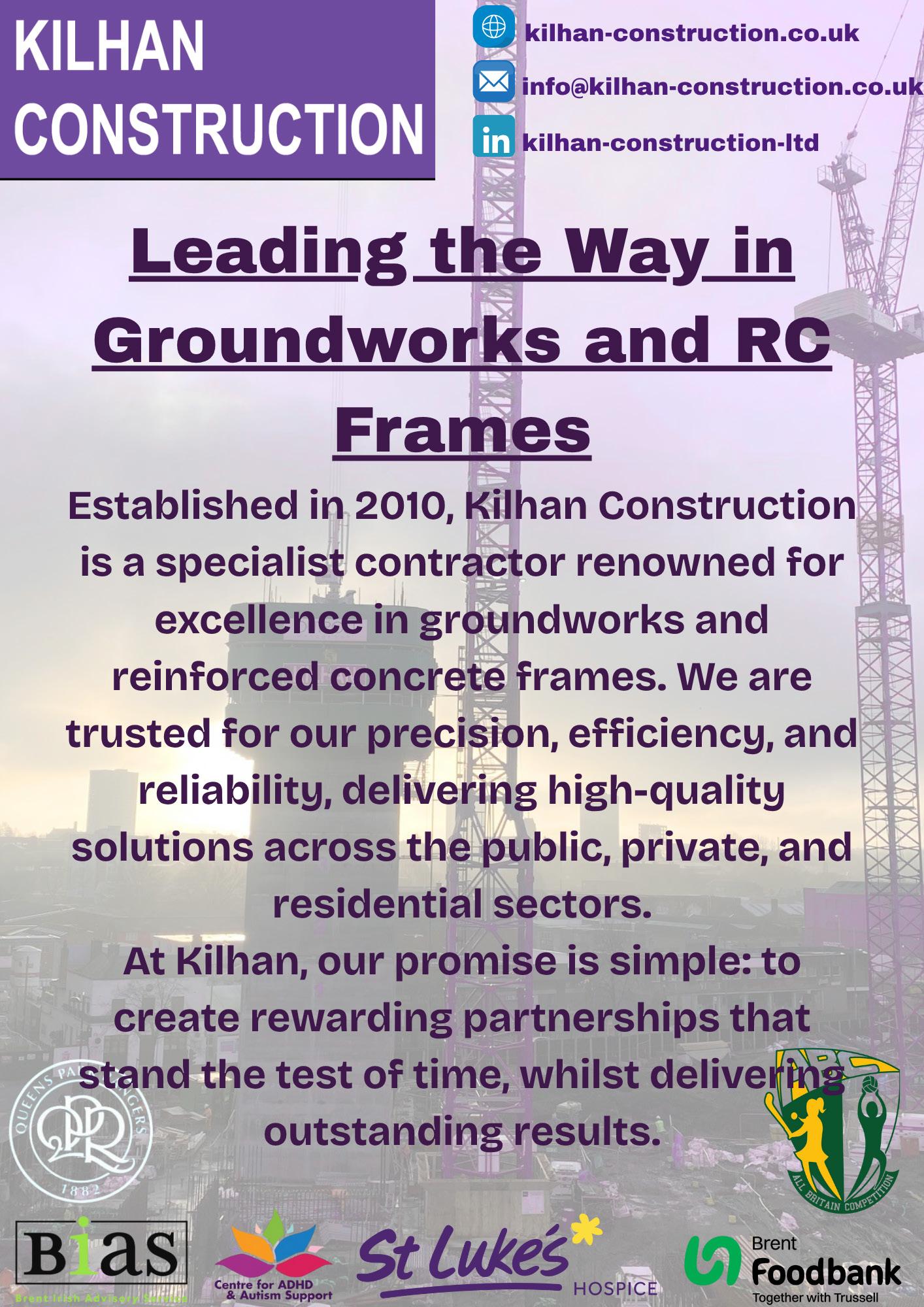

CONSTRUCTION SKILLS CRISIS
Long-term solution needed to replace ‘rapidly aging workforce’
URGENT action is needed to address a skills crisis which is “plaguing” the construction industry according to a leading trade body.
The Federation of Master Builders (FMB) says an ongoing skills shortage across the sector is worsening, and it is now “critically important” that trainees are recruited to fill the thousands of job vacancies across Britain.
Recent industry figures show over 35,000 construction job vacancies nationwide, with more than half of these positions unfilled due to skills shortages – which is the highest rate of any UK economic sector.
In its State of Trade Survey for Q4 2024 the FMB revealed that as much as 42 per cent of small, local builders across the UK reported having jobs delayed due to a lack of skilled labour.
This comes at a time when the UK faces a housing crisis, with the Government pledging to build 1.5million new homes.
According to FMB Chief Executive, Brian Berry the industry must recruit at least 250,000 new workers to meet growth projections and replace
its “rapidly aging workforce”.
“Our latest FMB State of Trade Survey shows that 33 per cent of our members are struggling to recruit bricklayers, while 37 per cent cannot find the carpenters and joiners they need,” Mr Berry explained.
“These aren’t just statistics – they represent real projects delayed, homes not built, and businesses unable to grow.
“If we don’t act decisively on skills development now, the UK’s ambitious housing and infrastructure goals will remain nothing more than an unrealistic aspiration.”
He added: “The skills gap isn’t just holding back individual businesses – it’s undermining our collective ability to build the homes, schools, hospitals, and infrastructure this country urgently needs.”
Mr Berry recently visited the Constructionarium training centre in King’s Lynn to emphasise the importance of practical, hands-on training to address Britain’s worsening construction skills shortage.
“What I’ve seen at Constructionarium perfectly illustrates what our industry desperately needs – training
that truly prepares people for the realities of modern construction,” he said.
“Facilities like Constructionarium exemplify the innovative approaches we need to champion across the country.”
The visit coincided with Constructionarium’s announcement of a partnership with the University of Southampton – which will bring together university students, educators, and industry professionals for immersive construction experiences designed to inspire and develop the next generation of construction talent.
Later this year, the site will
welcome students from as far away as Texas.
Similar training and expertise is being offered at construction training sites across the country as firms attempt to do their bit to address the skills shortage.
In Barnsley, south Yorkshire, Laing O’Rourke launched the UK’s first training facility for modern methods of construction last November.
A collaboration with Barnsley College and T3 Training & Development, the training centre represents a groundbreaking step in addressing the UK’s construction skills shortage as well as the need to modernise the industry.
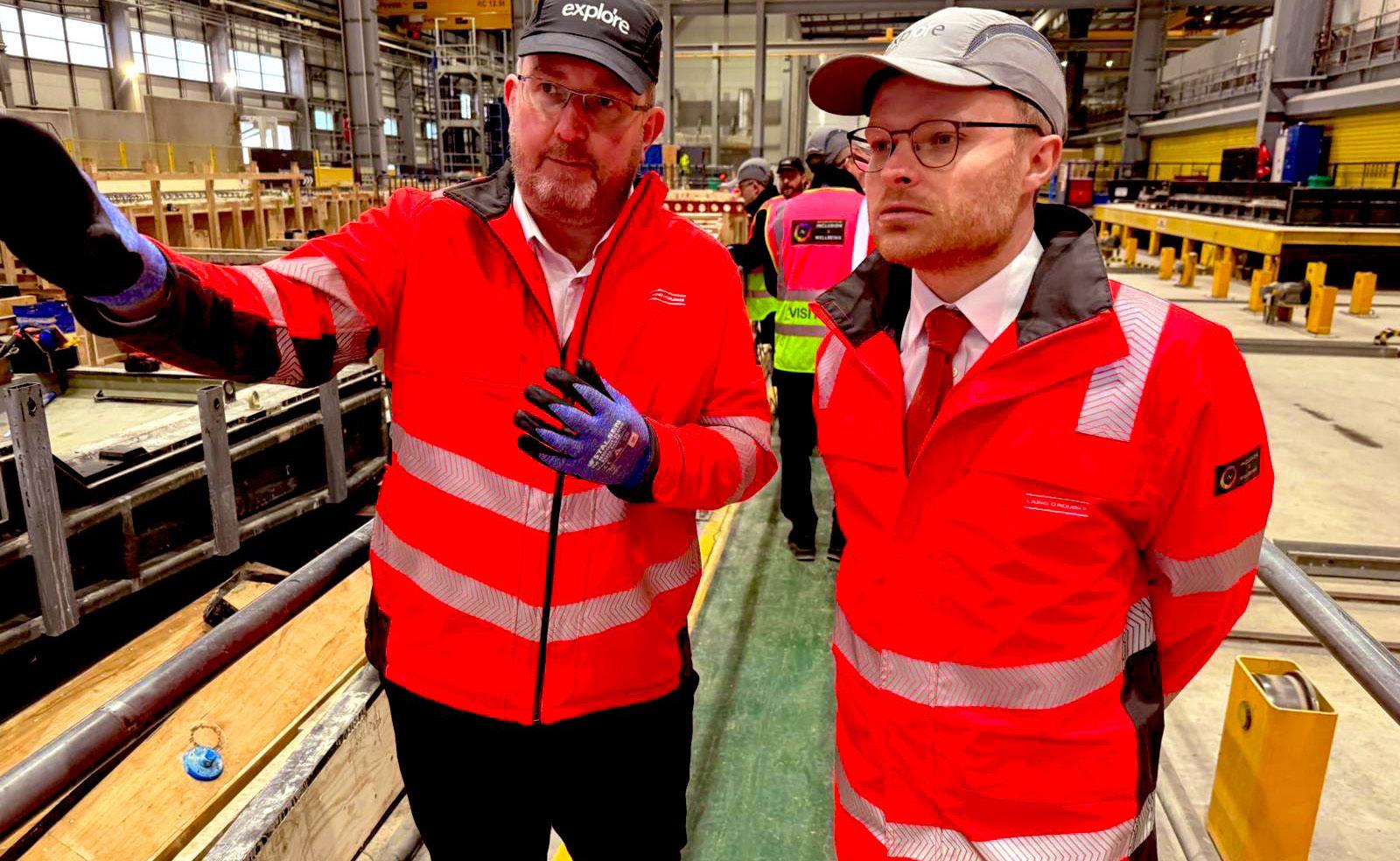
FMB Chief Executive, Brian Berry visited the Constructionarium training centre
The site, which is partfunded by the Local Skills Improvement Fund (LSIF), will provide people with the technical and digital skills required to assemble construction and engineering solutions that have been manufactured offsite.
This includes giving learners access to the equipment and skills needed to work with large-scale modular components in a safe and controlled environment as they are taught how to deliver sections of some of the UK’s largest infrastructure and construction projects.
It is the first purpose-built facility to offer its new Level 2 Apprenticeship in Construction Assembly installation, which was approved by the Institute for Apprenticeships and Technical Education (IfATE) in 2019.
“No other UK facility currently offers this bespoke off-site training, which is key to building faster, safer, and more efficiently,” a spokesperson for Laing O’Rourke said.
“The UK’s construction sector is at a pivotal moment, with more than 250,000 extra construction workers needed by 2028, to deliver the expected levels of work,” they added.
“To meet this demand, the industry must evolve, adopting manufacturing (off-site) and assembly (on-site) approaches to enhance productivity, safety, and environmental performance.
“This new qualification promises to help overcome the long-standing skills shortage in the sector and bridge the gap between young talent and experience.”
Laing O’Rourke has committed to pioneering modern methods of construction at the site for more than 15 years, in a bid to

attract students who wish to follow future careers that are safer, highly skilled and technical, in comparison to traditional construction approaches.
“We are proud and excited to launch this first-of-a-kind training facility with Barnsley College and T3 Training & Development, and to have created a training course that will help accelerate change across our sector,” Laing O’Rourke Director Peter Lyons said.
“Not only will it enhance the skills of our current directly employed workforce, but it will also attract a more diverse range of people to consider a career in construction.”
He added: “Only through the wider use of digital technologies and modern methods of construction can we transform productivity and create better work and careers for people.
“It’s a change we need to make to ensure we can deliver the essential infrastructure the country needs, and which underpins our quality of life.”
The Modern Methods of
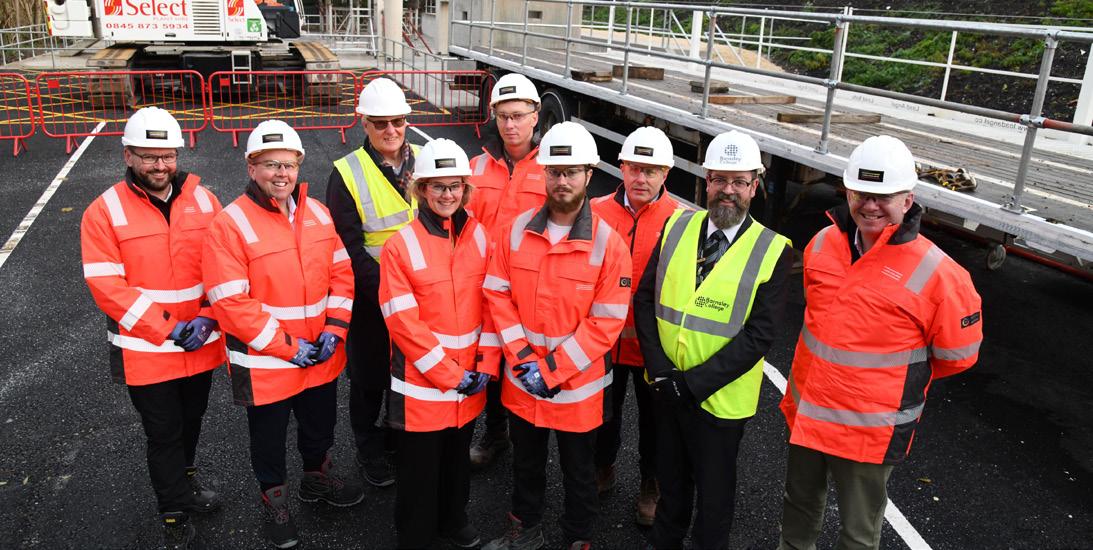
Construction Training Centre welcomed its first cohort of apprentices at the start of this year.
There is similar focus on contemporary skills and training in Ireland too, where a new platform has just been launched to drive innovation and skills in the nation’s construction sector.
Last month Higher Education Minister James Lawless revealed the new Skillnet MMC Accelerate platform at the National Construction Training Campus in Co. Offaly’s Mount Lucas.
The national online platform aims to empower Ireland’s construction sector to meet its housing and infrastructure targets by fast-tracking the adoption of modern methods of construction.
“Ireland stands at a pivotal juncture in the construction of housing and infrastructure,” Minister Lawless said as the platform was launched.
“While we face enormous challenges, we also face exciting opportunities,” he added.
“This national platform will empower our construction learners and workforce with the tools, knowledge, and opportunities to thrive in a sector that is rapidly evolving.”
He explained: “This platform is more than a resource; it is a statement of intent.
“It says loud and clear that when we invest in people and their skills, we will have the ability not just to build homes, but to build people’s futures.”
Minister of State Marian Harkin has also welcomed the initiative.
“Whether you’re a site supervisor looking to reskill, a school leaver looking for your first apprenticeship, or a business leader trying to stay ahead of digital change, the MMC Accelerate platform is your starting point,” she said.
“This platform brings clarity. It connects learners to providers. It puts the user in the driving seat of their own development journey.”
For Dr. Alan Hore of CitA, who is the Programme Lead for Skillnet MMC Accelerate, the need for training in contemporary construction methods could not be greater.
“The construction industry is transforming, and MMC is at the forefront of this shift, making it leaner, greener, and more digitally advanced,” he said.
“By providing a platform for career growth and opportunity, we can ensure the industry attracts top talent and embraces innovation.
“This new online resource represents a significant step-change for the sector, responding to industry needs and providing professionals with the advanced skills and knowledge to deliver highquality, sustainable housing and other important national infrastructure at scale.”
The team at the Modern Methods of Construction Training Centre in Barnsley
Ireland’s Higher Education Minister James Lawless



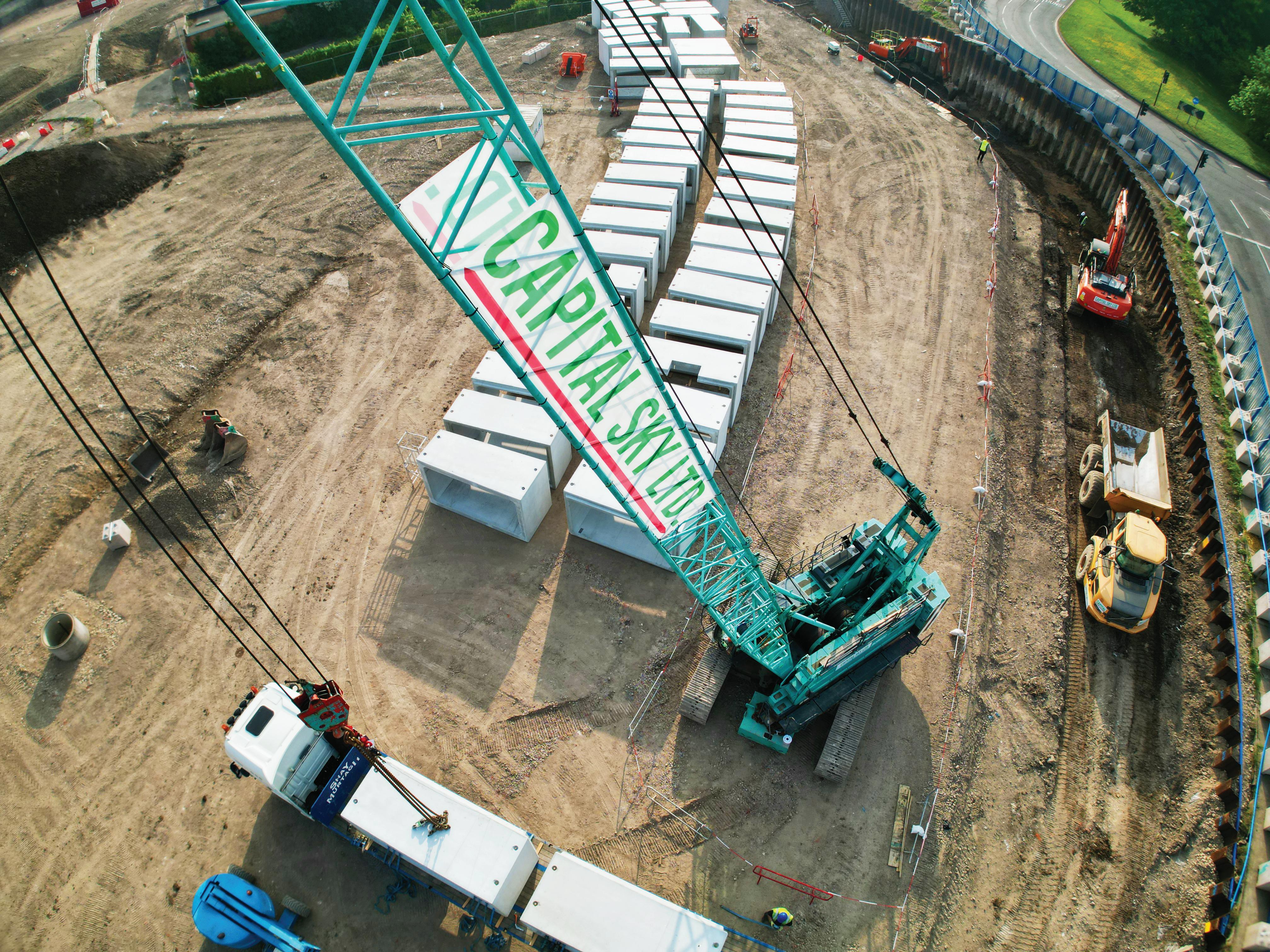


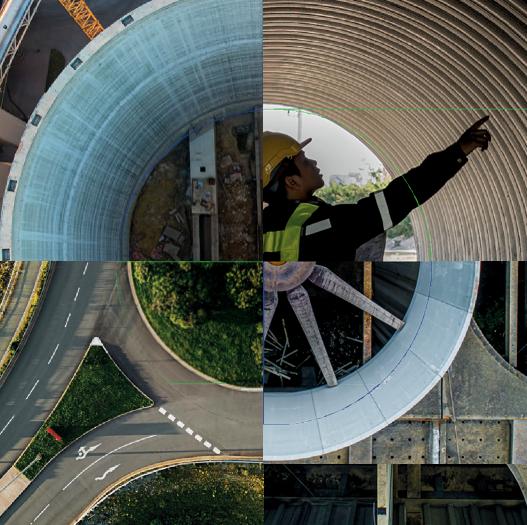







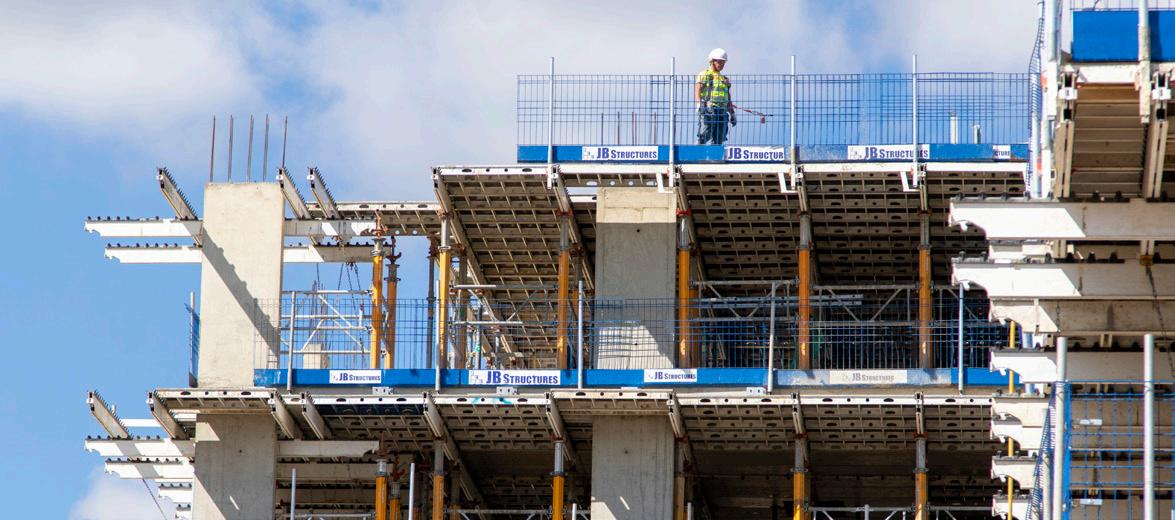
Fans, water and golf to get clients through the summer

With temperatures predicted to be in the mid 20’s, Cara Stationery has
In comparison to air conditioning, fans are cheaper, smaller, and have an immediate cooling effect on skin. Fans cool you, but do not reduce the temperature in the room. However, if you place a bowl of ice water in front of a fan then heat energy is removed from the air to melt the ice.
Bottled water or mains fed water are a must have for sites and Cara stock a wide range of water dispensers to help clients comply with strict staff welfare legislation. And golf … well not alone do they supply golf merchandise, but the Cara



Cara Stationery Team members Dermot Wilson, Michael Farrelly, Gerry Keany and Tom English

POWER PLAY
Lucrative contracts tempt Irish firms into Scotland
MAJOR contracts have been tempting Irish firms to broaden their horizons in Scotland.
This year alone has seen many organisations expanding into northern Britain, where their skills and offerings have helped them win valuable places on important jobs.
Scotland is one of the world’s most developed markets for offshore wind and renewable energy.
It currently has more than £50bn worth of projects in development in this sector –which is also an area where Irish companies bring worldclass engineering, technology, and environmental expertise.
It may be no surprise then to see many Irish firms named as partners on some of the major projects underway in Scotland.
So substantial has been the influx of Irish firms on the Scottish scene, that Enterprise Ireland has set up a new branch in Glasgow to support their success in the region.
In May they officially opened their new Glasgow office, their third office in the UK, adding to existing offices in London and Manchester.
“Enterprise Ireland’s new Glasgow office signals a long-term commitment to Scotland as a key market and will further support the success and impact of Irish
enterprise across the UK, our largest export market,” Enterprise Ireland’s Regional Director for the UK, Nordics & New Exporters, Deirdre McPartlin said.
“Scotland represents a dynamic growth market for Irish companies and its unique characteristics are best understood through a local presence.”
She added: “For the offshore wind sector, Ireland’s established capabilities in engineering, marine services, and grid technologies are positioning its firms as key contributors to Scotland’s clean energy transformation.”
Limerick-founded Kirby
Engineering been named as one of the preferred partners of Scottish Power as they deliver what they describe as the “largest-ever overhaul” of the electricity grid in Scotland.
Kirby’s Director of Power and Renewables, Michael Murray said: “We are delighted to be confirmed as a preferred partner under this Scottish Power programme, delivering the biggest overhaul of the electricity grid ever seen.
“This SP initiative is part of the largest rewiring of the GB electricity grid since its inception aimed at meeting increasing demand and facilitating growth in this important sector.
“This partnership is another major milestone for our Glasgow team and further strengthens Kirby’s longestablished relationship with Scottish Power.”
SP Energy Networks have confirmed the 19 businesses which have been selected as preferred partners for the £5.4bn supply chain contract programme, which will help the network operator deliver the biggest rewiring of the British electricity grid since its inception.
Seventeen of those 19 contractors are headquartered in the UK and Ireland.
They include the Irishfounded Keltbray Energy Limited, which is headquartered in Surrey, and was recently announced as the winner of Scottish Power’s Supplier of the Year Award.
Keltbray will deliver work across both overhead lines and substations on the five-year contract, which has the option to extend up to 10 years.
Nicola Connelly, CEO of SP Energy Networks, said of their partnerships: “We’re delivering the biggest overhaul of the electricity grid ever seen to
unlock growth and free up network capacity for new homes, businesses and clean energy projects.
“These strategic partnerships will give suppliers the confidence to invest in themselves, growing their workforce, opening new offices across the country and creating even greater opportunities for the UK.
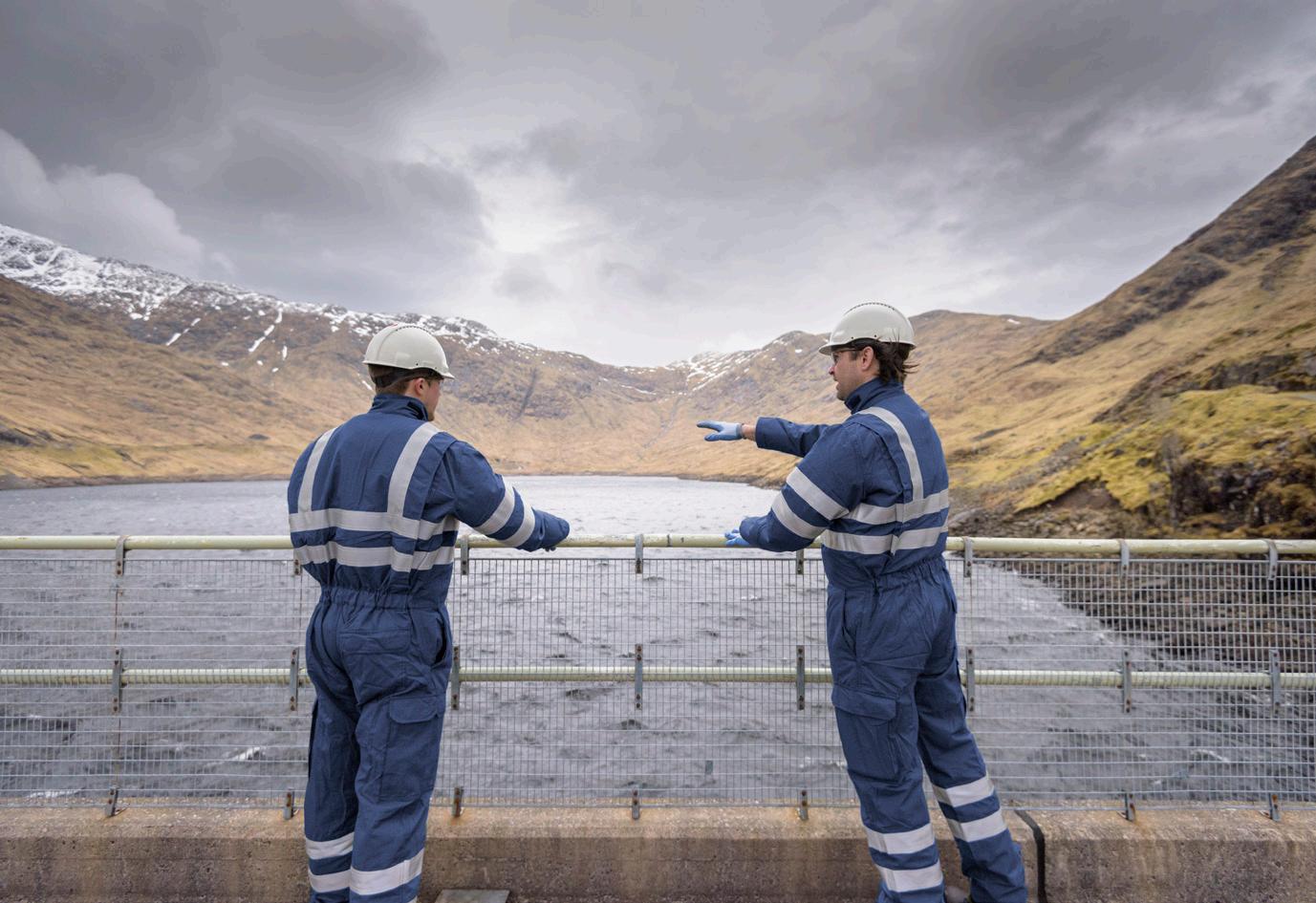
“This is great news for the UK and Scottish supply chains, with every pound spent directly benefiting central southern Scotland and its infrastructure for decades to come.”
The Scottish Government is also happy about the arrival of Irish firms on the scene.
“Scotland is open for business, and I am delighted to see so many Irish companies
taking advantage of the wealth of investment opportunities available, particularly in our rapidly expanding renewables sector,” Scottish Government Minister for Business, Richard Lochhead said.
“They are creating good, well-paid jobs and boosting economies on both sides of the Irish Sea,” he added.
“These are strong foundations upon which the Scottish Government is
committed to build.
“The current international headwinds make this increasingly important, and we will co-operate with our close partners to deepen trade relationships and remove barriers to investment.
“I look forward to working with [Ireland’s] Minister Niamh Smyth to grow the already strong economic relationship between our two countries.”
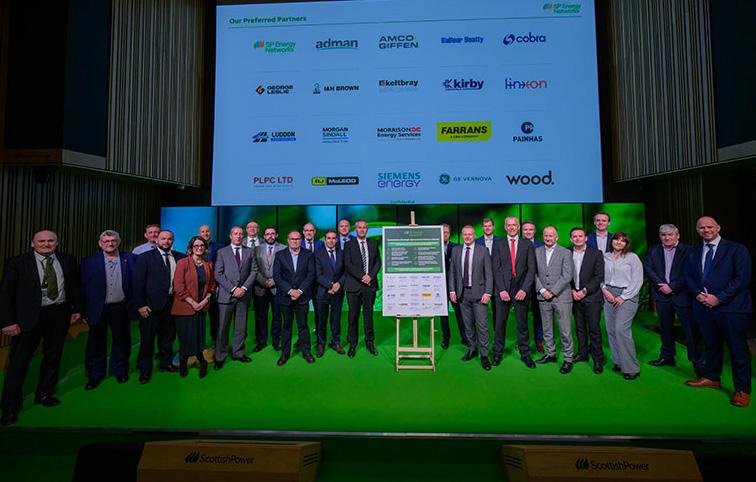
SP Energy Networks have confirmed their 19 preferred partners for the supply chain contract
Scotland’s energy and renewables sector is rapidly expanding
Expanding overseas Irish firms that are successfully branching out in Scotland
Subsea Micropiles
Dublin-based Subsea Micropiles have launched a pioneering offshore wind anchoring solution, with its first commercial installation for Orkney Harbour Authority in Scotland. Earlier this year the firm announced that they have secured an investment of £9.2m, led by the Scottish National Investment Bank, to further advance its technology and expand operations in Scotland, with plans to create 100 jobs over the next five years.
Uniquely
Customer service and sales outsourcing provider Uniquely have announced an office opening in Glasgow with a commitment to create 300 jobs across the UK with 100 jobs based in Scotland within 12 months.
Headquartered in Galway, the firm also has branches in counties Louth and Kerry and in Birmingham in England.
Cleantech Civils
A leading provider of civil engineering, design and building solutions, Cleantech Civils deliver projects across water and wastewater infrastructure and the wider built environment. This year the Cavan-based firm announced the opening of its Scottish office in Coatbridge, North Lanarkshire.
Senus
Founded in 2017 by Dr Eoghan Finneran, Brendan Allen, and Joe Desbonnet as a spin-out from a University of Galway research project, Senus is an environmental
data management company. Earlier this year it announced a partnership with Scotland’s AgriGroup. The firm is now headquartered in Co. Roscommon.
Easyfix
Founded in Galway, Easyfix now has an office in North London and recently announced a new distribution partnership with Thorburn, which will focus on clients in East and Southeast Scotland.
The livestock comfort manufacturer has a mission to “create a farming community that places livestock comfort, welfare and environmental sustainability at the forefront”.
TEKenable
A leading digital transformation consultancy and Microsoft Solutions Partner, Dublin-based TEKenable has been selected to deliver a comprehensive digital transformation programme for the East Lothian based PureMalt, which is a leading manufacturer of malt-based ingredients.
The Dublin firm will now get to work on modernising PureMalt’s manufacturing and operational capabilities to enable scalable growth, enhanced traceability, and real-time data-driven decision-making at the organisation.
McGrath Limestone (Cong) Based in Co. Mayo, as the name may suggest, McGrath Limestone (Cong) is a leading supplier of high calcium
limestone products. This year they have invested in new silos and storage facilities in Fife, in partnership with JLW Solutions to secure their future continued supply into the Scottish market.
Rubicon Archaeology
Cork’s Rubicon Archaeology is a leading archaeological consultancy delivering expert heritage services throughout Europe. It has recently been awarded an archaeological investigations contract valued at £2m to support the construction of the A9 Dualling: Tay Crossing to Ballinluig project in Scotland. The firm has also announced it is opening a new Scottish office, due to be located in Bathgate, West Lothian, in response to the “growing demand for archaeological services in the Scottish market”.
Glennon Brothers
Earlier this year Longford based Glennon Brothers opened their new timber
frame manufacturing facility Alexander Timber Design (ATD), in Irvine, Scotland. The £18m spend by the Irish firm brings their total investment in Scotland to date to over € 80m. To mark the occasion, First Minister of Scotland, John Swinney officially opened the new site, which has been described as the UK’s most technologically advanced timber frame construction facility.
Suir Engineering
Founded in Waterford in 1984, Suir Engineering quickly established itself a leading firm offering exceptional project delivery. It has since grown internationally, with clients across Europe and the Middle East. In January, the firm announced the acquisition of Taylor and Faser, a leading mechanical and electrical construction engineering company, with a 100-year history in Scotland, to expand its operations and customer base in the UK.
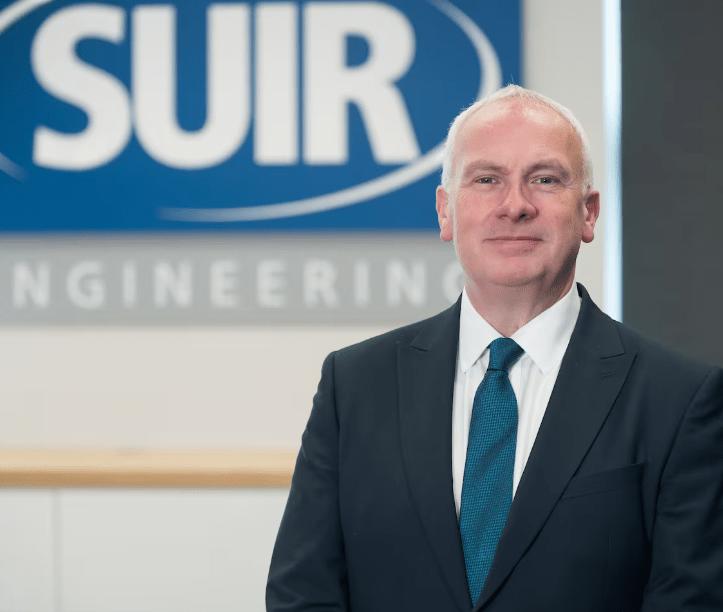
Suir Engineering CEO John Kelly




‘OUR INDUSTRY NEEDS MORE WOMEN’
Murphy’s Joanna Mulcahy believes visibility is key in achieving a more gender balanced construction sector
JOANNA MULCAHY knew early on that she wanted to pursue a career in construction.
While studying at a convent school she was advised to become a nun or a missionary, but she had other ideas.
A career in the world of engineering and the built environment beckoned and two decades later Ms Mulcahy remains as committed now as ever to that path.
She is similarly committed to developing the next generation of professionals within the sector and is an advocate for a gender balanced workforce, better mental health provision for industry workers and mentoring new recruits.
Ms Mulcahy is also a trustee with the Lighthouse Charity, which provides support for construction industry workers.
This week she told us more about her role and her targets for the year ahead…
Tell us about your role at Murphys
My journey began as an assistant quantity surveyor, and over the past two decades, I have held various roles within the civil, energy, major
projects, and transportation sectors of the business.
As Commercial Director at Murphys, one of my key responsibilities is overseeing the ‘Great Grid Upgrade’ for National Grid which is the largest overhaul of the electricity grid in generations. We are one of seven industry partners appointed to deliver this significant programme of works, which aims to build the new electricity network infrastructure required to reduce the UK’s reliance on fossil fuels.
This initiative is a brilliant opportunity to contribute to the nation’s energy infrastructure and drive sustainable development.
The magnitude and pace of this project demand that we come together as an industry and adopt new ways of thinking and operating, which is incredibly exciting to be a part of.
Did you consider any other career path?
I attended an all girls’ convent school where programmes and career advice were limited. I was encouraged to either become a nun or a missionary, but neither path resonated
with me. Initially, I considered a career in law, but my passion for the construction industry and the opportunities it presented led me to pursue this field.
The dynamic nature of construction, combined with the ability to shape the built environment, solidified my decision to build a career in this industry.
What are the most rewarding aspects of your job?
The ability to influence and drive significant projects that shape our communities and infrastructure is incredibly rewarding.
Seeing a project come to life from conception to completion and knowing that it will positively impact people’s lives is enormously fulfilling. Additionally, creating world class infrastructure that sets new standards for quality and innovation is a source of immense pride.
Mentoring and developing the next generation of professionals, particularly women in construction, also brings me great satisfaction, as it ensures the continued growth and success of our industry.
What do you think are the biggest challenges for the construction industry today?
One of the biggest challenges is addressing the skills gap and ensuring that we have a workforce equipped with the necessary skills to meet the demands of modern construction.
The industry must also continue to innovate and adopt sustainable practices to reduce its environmental impact.
Navigating economic uncertainties and maintaining profitability while delivering

Trailblazer Joanna Mulcahy
high quality projects is also a significant challenge.
What one piece of advice would you share with women considering a career in construction?
Be confident in your abilities and seek out mentors and role models who can provide guidance and support. The construction industry offers diverse opportunities, and your unique perspectives and skills are valuable.
Embrace these opportunities with confidence and curiosity, and you will discover that your potential is truly limitless. Don’t be afraid to challenge the status quo and strive for excellence in everything you do.
What can be done to encourage more women into construction?
Women make up approximately 15 per cent of the construction workforce in the UK. This is a significant increase compared to previous years, but there is still a long way to go to achieve gender parity in the industry. To encourage more women into construction, we need to promote the industry as an inclusive and rewarding career choice from an early age. This involves engaging with schools and universities, showcasing successful female role models, and providing mentorship programmes. I actively work with young students to help shape career aspirations.
A few years ago, I was invited to my son’s school to give a talk to the reception class. I went into the classroom wearing my full PPE and the children started singing “Bob the Builder”, including my son. They were incredibly surprised when I took off my hard hat and safety goggles, as they all expected to see a man. This experience highlighted
how stereotypes are ingrained from a young age, and it underscores the importance of reaching out to children early to challenge these perceptions. It’s also crucial to ensure young females are aware of the diverse career options available in construction and understand how fulfilling and rewarding the industry can be.
For instance, my eldest daughter recently had a day placement for work experience with us and was amazed by the variety of roles within the industry. This kind of exposure can be incredibly impactful in shaping career aspirations. I truly believe in the power of visibility.
As the saying goes, ‘she believed she could, so she did’. There aren’t enough women in the industry for young girls to see and think, ‘if she can, I can’, By encouraging more women to pursue careers in construction, we can tap into a wider talent pool, ensuring that we have the skilled workforce needed to meet future demands.
What could change your industry to make the biggest impact?
Creating an environment where people feel comfortable to talk about their struggles could have a significant impact on the construction industry. Mental health issues are prevalent in our sector, with construction workers being three times more likely to take their own lives than the national average.
This statistic highlights the need for support within our industry and creating an environment where wellbeing is prioritised is important. When employees know that their wellbeing is taken seriously, they are more likely to stay with the company and perform at their best.
This, in turn, can lead to better project outcomes and a more


positive work environment.
What lessons have you learned in your career that can inspire others to succeed?
One of the key lessons I’ve learned is the importance of resilience and adaptability. The construction industry is constantly evolving, and being able to navigate challenges and seize opportunities is crucial. Building strong relationships and maintaining a positive outlook can also make a significant difference in achieving success.
Lastly, continuous learning and professional development are essential for staying ahead in this dynamic field.
What motivated you to become a trustee of the Lighthouse Charity?
The Lighthouse Charity works closely with our business and has a mission that deeply resonates with me.
I am committed to improving the overall culture of our construction industry and I am passionate about supporting initiatives that promote positive wellbeing and skills development within the sector.
The charity’s proactive support for apprentices and students also aligns with my belief in the importance of nurturing future talent and creating a more inclusive industry.
The construction industry faces significant challenges with wellbeing issues and we all have a role to play in helping to support each other.
The Lighthouse Charity is at the forefront of providing that support and their dedication to improving mental health and wellbeing in our sector is unparalleled, and I am honoured to be a part of such a vital organisation.
How does your daily work tie in with being a Lighthouse
Charity trustee?
My work as a Commercial Director involves strategic decision-making, risk management, and fostering a positive company culture, all of which align with my role as a Lighthouse Charity trustee. In both roles, I am committed to ensuring that resources are managed effectively and that our mission is fulfilled.
This includes making key decisions and maintaining high standards of compliance and ethics.
By leveraging my industry experience and network, I can contribute to the charity’s mission and help drive meaningful change.
My work in the construction industry has given me a deep understanding of the unique challenges faced by people and this insight allows me to advocate for effective support systems and initiatives that can make a real difference in the lives of construction workers.
Finally, what’s your next big challenge?
As a Commercial Director of Murphys, my biggest challenge is a combination of balancing sustainable growth with innovation, attracting and retaining top talent, whilst being unwavering in my commitment to achieving zero harm. Our business purpose is to deliver world class infrastructure projects that improve lives. To achieve this, we must integrate advanced technologies to enhance efficiency and project outcomes, all while ensuring we have the right people with the right skills to drive our success. By overcoming these challenges, we can continue to cultivate an organisation that adeptly navigates change and consistently delivers exceptional results beyond our client’s expectations.
Women need positive role models in the industry
Natalie Ryan, Partnership Manager at The Lighthouse Charity Out of office with…
The Lighthouse Charity provides 24/7 support to members of the construction industry community across the UK and Ireland.
That covers all aspects of emotional, physical and financial wellbeing and is delivered across a range of methods - from their free 24/7 helpline, to their live web chat service and a text facility which provides information, guidance and support on a huge variety of wellbeing issues.
They also offer a free self-support app as well as Lighthouse Beacons - physical
WHAT’S YOUR FIRST TASK WHEN YOU GET TO THE OFFICE IN THE MORNING?
Working from home I always look at the day ahead to ensure I plan appropriately.
On a Monday I always look at the full week ahead, but no day is the same.
I could be at a company awareness day, letting them know about our charity’s support services, delivering presentations to our company supporters or meeting fundraisers. Getting to meet so many amazing people is one of the highlights of my job. I should probably also mention that I always do my planning with a nice big cup of Barry’s Tea.
WHAT MOTIVATES YOU?
My job. As the Partnership Manager for the Lighthouse Charity in Ireland for the last two and a half years, I have seen an amazing growth in awareness of the support we offer to our construction community.
In a previous role at CPAS, a pensions, life assurance and illness benefits provider for the construction industry, I gained great insight into some of the issues our workforce face on a
spaces where construction workers can share their concerns.
Based in Dublin, Natalie Ryan has been Partnership Manager with the charity for two and a half years.
The 38-year-old, who was born in the city, but has family in the East Midlands and London in the UK, has worked within the construction industry for the past 17 years.
Over those years her work has given her an in-depth understanding of the pressures being faced by many employed within the sector.
daily basis.
I was often on sites delivering information to maybe 300 people, helping them to plan for their futures and having the financial resilience to cope with illness and injury.
As well as giving me the confidence to speak with such large groups, that insight also influenced me to seek a role where I could really make a difference.
When I’m at events I hear firsthand, stories of the people we have been able to help –often making a life changing difference.
Our actions create ripples, and the message of support also positively impacts on family, friends and colleagues.
Being able to increase the awareness of our fantastic charity and provide emotional, physica and financial support to those who need it most, is what motivates me every day.
WHAT WAS YOUR FIRST JOB?
Working in our family B&B, cleaning, serving breakfasts, making beds - a bit of everything really.
It made me understand the importance of each task, however small it may have

Lighthouse Charity works to alleviate those stresses, and it is Ms Ryan’s role to help the organisation achieve that.
seemed at the time and how all of those things ultimately contributed to the success of the business.
It was also great to meet so many people from different places and backgrounds.
I think all of this gave me excellent grounding for life.
DO YOU HAVE A WORK/ BUSINESS MOTTO?
Our charity’s vision is that no worker should feel alone in a crisis.
Our mission is to ensure that our construction workforce can easily access the emotional, physical and wellbeing support they need and to develop healthy and sustainable futures for this generation and the next.
From a personal perspective my mantra is, ‘don’t procrastinate, get it done, and do a 20-minute focus task to stay on track’.
WHO INFLUENCED YOU MOST IN YOUR CAREER?
My dad. He has always been very driven and has a keen entrepreneurial spirit, managing his own businesses and being self-reliant.
It is a role which she finds “incredibly rewarding”, she says, and one where she gets to “work with a great team”.
He also went back to university as a mature student whilst raising me and my brother and sister.
He’s very positive too which is a great characteristic to have. He taught me that everything is possible.
WHAT’S THE BIGGEST CHALLENGE FACING YOUR INDUSTRY TODAY?
The stigma of asking for help, and not enough encouragement from companies and peers to reach out for support.
One of the ways we are

The
The General Post Office (GPO) building in Dublin’s O’Connell Street
tackling it is though our #MakeItVisible initiative.
Our make it visible on-site team are reaching some of our industry’s most vulnerable workers.
Meeting people face to face, sharing their lived experiences and encouraging people to talk about their concerns.
Knowing that you’re not alone can make all the difference.
Having people within an organisation that can spot the signs of someone struggling and having the confidence to step in and support them is also crucial.
That’s where our mental health first aid (MHFA) training really comes in.
It gives people the skills and knowledge to be able to ask questions and signpost someone to expert help.
WHAT’S YOUR BIGGEST GOAL FOR THE NEXT 12 MONTHS?
We continue to go from strength to strength in Ireland and we need to keep increasing

the awareness of our services.
We have an incredible volunteer committee who I meet with once a month to work on increasing the awareness across their projects and communities.
We learn from each other’s knowledge and experience and knowing that we are all making such an impact on our community is very humbling.

WHAT’S THE BEST LIFE LESSON YOU HAVE LEARNT IN YOUR CAREER?
Keep an open mind and don’t take things personally.
Never stop learning and seize any opportunity that comes your way, whether it’s learning a new skill or the opportunity to meet new people.
WHAT IS YOUR FAVOURITE
BUILDING IN BRITAIN (AND WHY)?
Big Ben, (or the Elizabeth Tower to use its proper name) always stands out as a childhood memory.
My dad brought myself and my brother and sister to London for a few days.
Big Ben looked huge and there probably isn’t anyone that doesn’t recognise the iconic tower and clock faces.
WHAT IS YOUR FAVOURITE BUILDING IN IRELAND (AND WHY)?
The GPO in Dublin - its iconic with so much history. It looks amazing at any time of year but at Christmas its always done up with a beautiful display as part of the Dublin Winter Lights event for children, now an annual favourite my son loves.
Established in 2001, ROL have enjoyed continued and successful growth.
Using innovative materials, alongside tried and tested methods, we ensure projects are delivered on time and to a high standard.
We take pride in our performance and often develop ongoing relationships with our many clients. Visit our website to view project case studies, or contact us on the number below to discuss how we can help you.
n Large scale groundwork and reinforced concrete projects undertaken
n Specialists in groundwork and RC Frame
n Highly skilled and motivated workforce using the latest innovative methods & materials

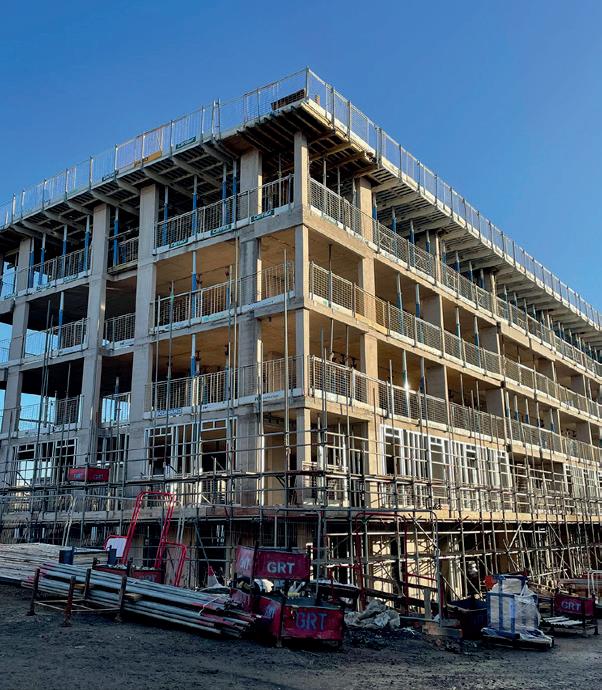
Big Ben in London’s Westminster
Industry leaders get networking
BUSINESS leaders from across all sectors were out in force for a recent TLICN event.
The London Irish Construction Network (TLICN) enjoyed its ninth annual parliamentary reception at the Terrace Pavilion, within the House of Commons in Westminster.
The evening was sponsored by Liam Conlon, who is the current Chair of the Labour Party Irish Society and the MP for Beckenham and Penge.
Formed in 2009, TLICN hosts a number of networking events throughout the year, often engaging high profile speakers.
The network prides itself on its ability to “bring member companies together, creating opportunities for them to develop and grow their businesses”.
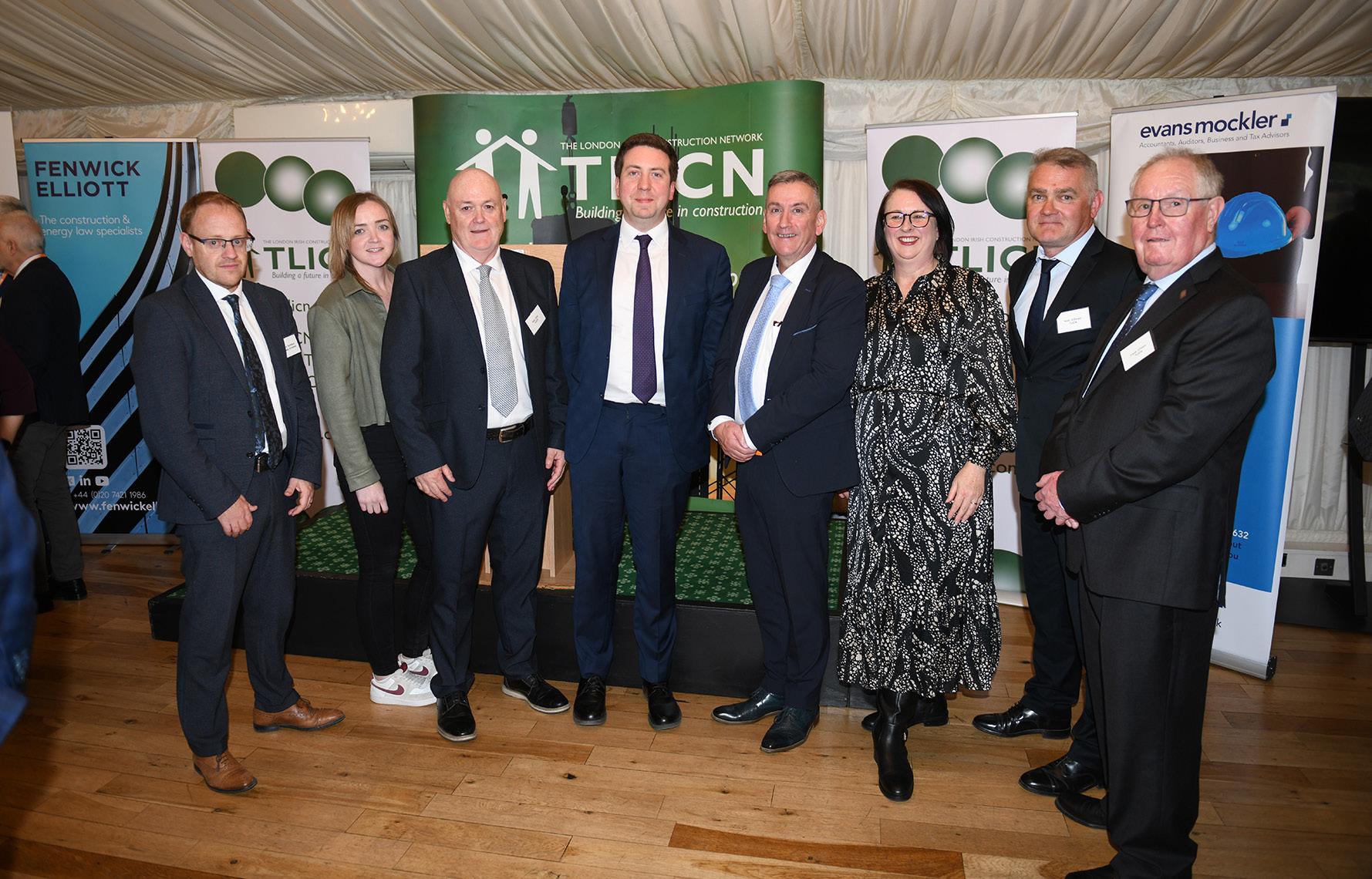




Pictures by Malcolm McNally Photography
Donal Sheehan, Sean McGrath (Apex) and TLICN Director Con O’Sullivan
Richard Carron (Carron Connected), David O’Reilly (British Irish Chamber of Commerce) and Darren Hammill (Keenwood Joinery)
Darren Heneghan (Rework Recruitment) and Niall Healy (Healy Cornelius Design)
Michael Byrne (Byrne Group) and Aidan King (John Sisk & Son)
Liam Conlon MP is pictured 4th left with Patrick Rochford from the Irish Embassy and TLICN Directors Nicole and Sean Daly, Con O’Sullivan, Mary Pottinger, Niall O’Dowd and Frank O’Hare

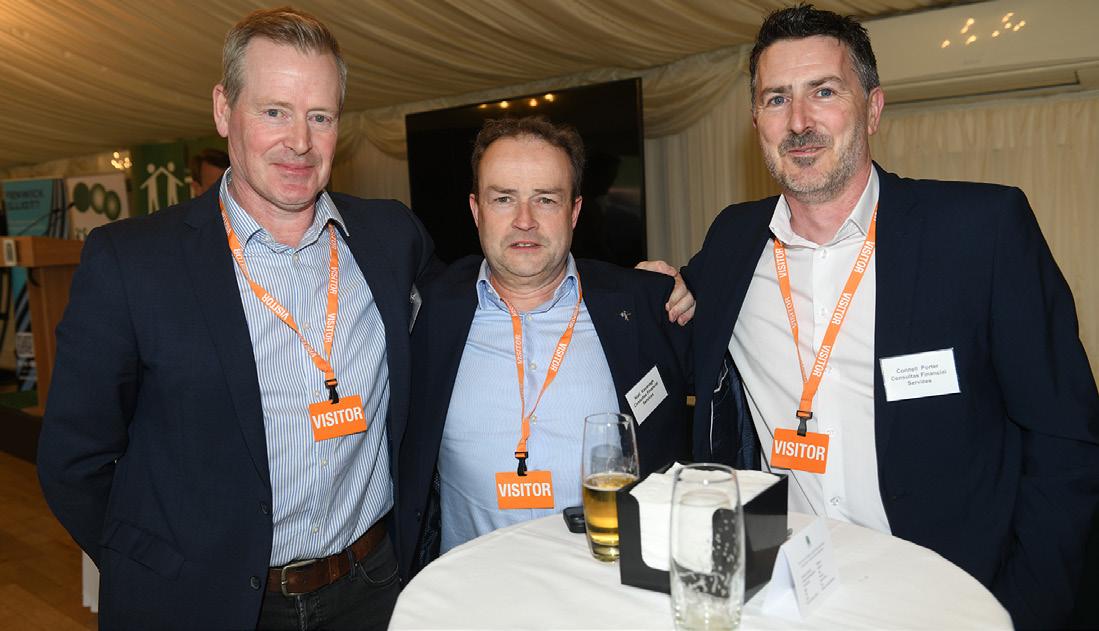
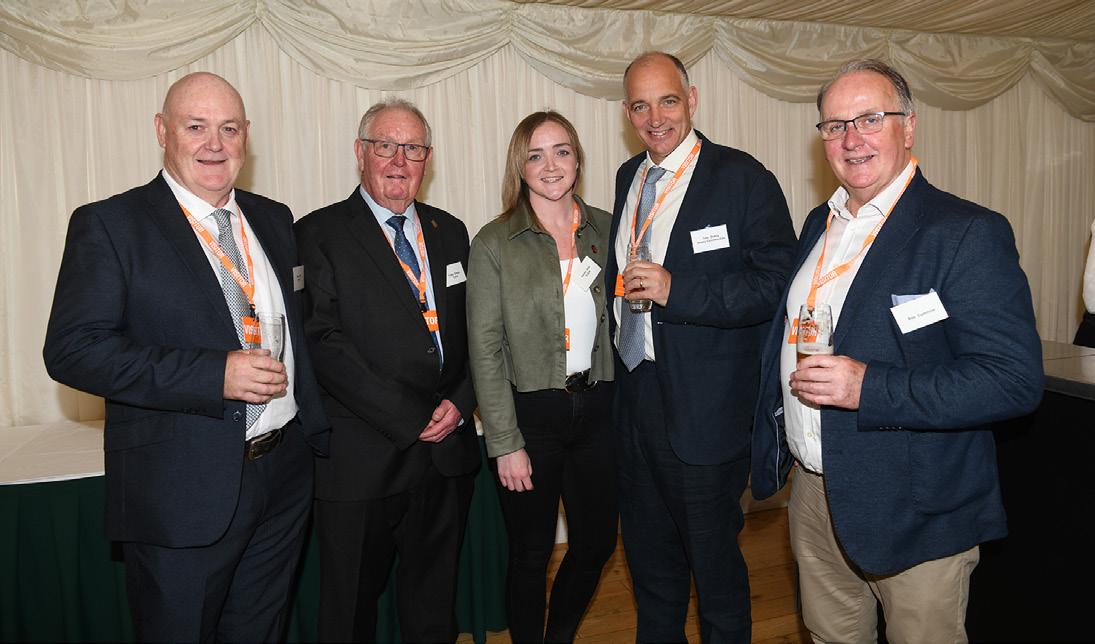
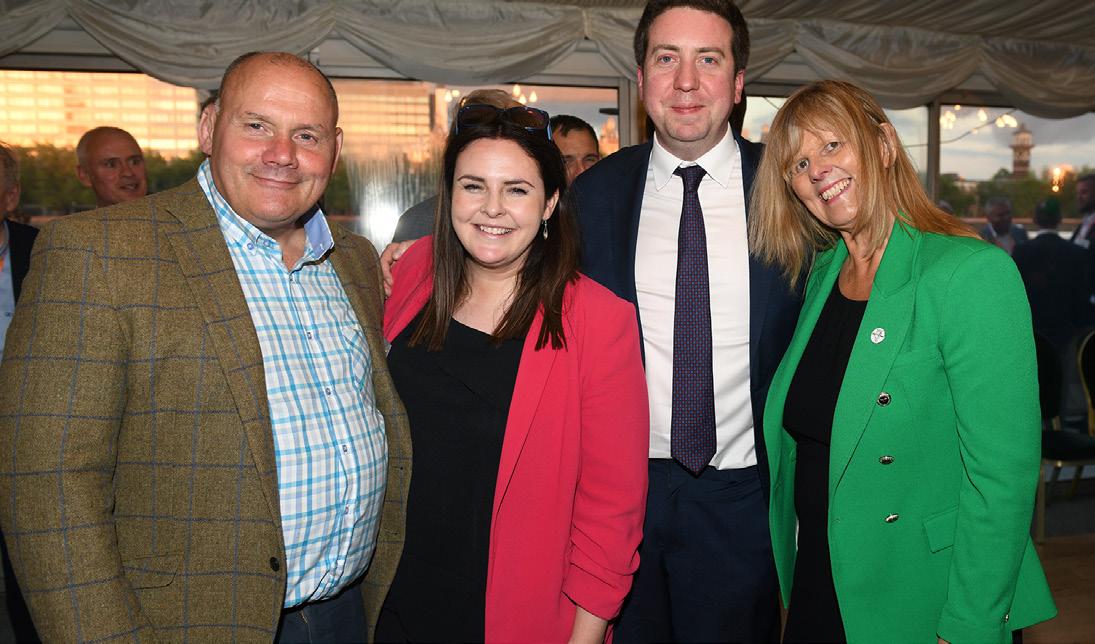
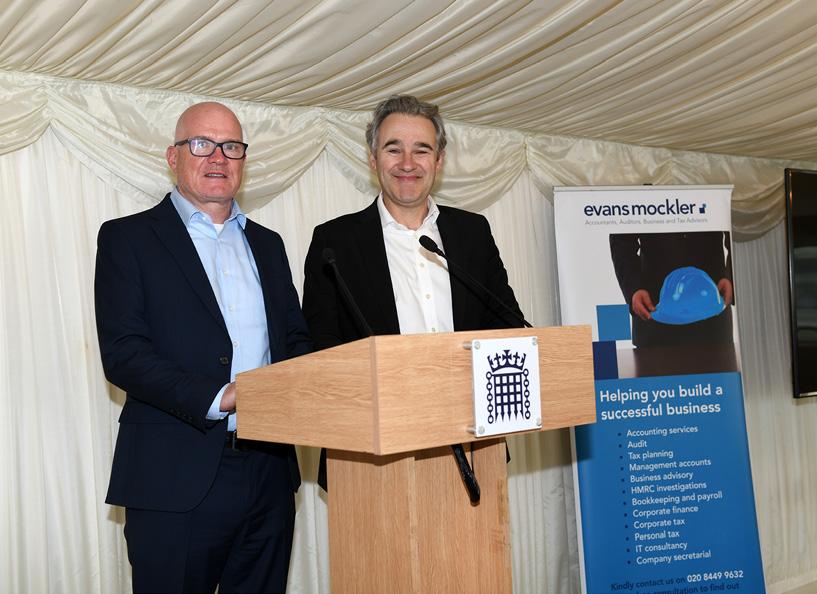
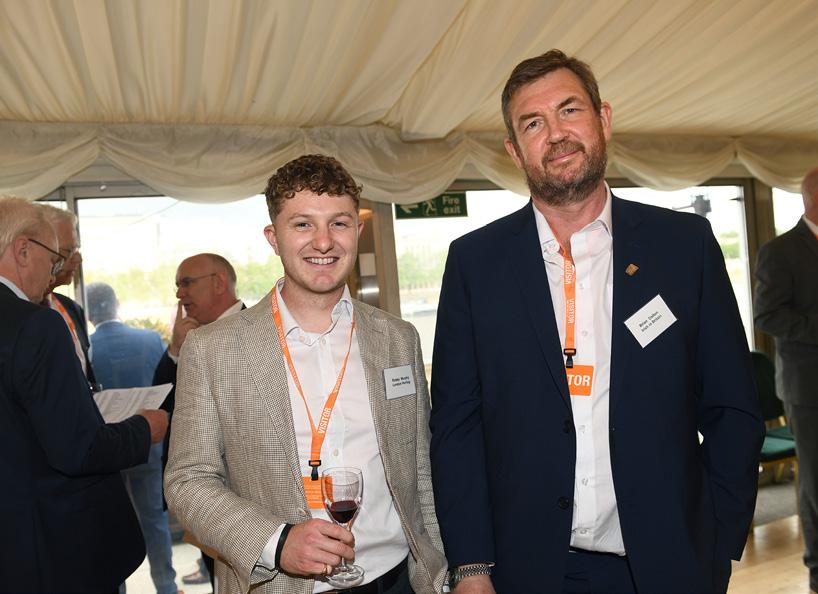





Sean O’Sullivan (Cork Marts), Liam Conlon MP, Tom Kelly (Cork Marts), John Casey (JJ Casey and Co) and Frank Feighan TD
TLICN Directors Sean Daly, Frank O’Hare and Nicole Daly, Tom Deacy (Deacy Construction) and Bob Cummins (X Construct)
Mick McCormack (Derlin Construction), Cllr Claire Tighe from Ealing Council, Liam Conlon MP and Claire McCormack (Derlin Construction)
Alan Tyrrell (EDC Engineers), Alysa Shadbolt (Shadbolt Doors) and Mustafa Omar, Eleanor Cox and Jim McFadzean (all Lloyds Bank)
John Connelly, Niall Kavanagh and Connell Porter (all Consultas Financial Services)
Vincent O’Brien (Ryanair) and Martin Mockler (Evans Mockler)
Robbie Murphy (Intuit) and Brian Dalton (Irish in Britain)

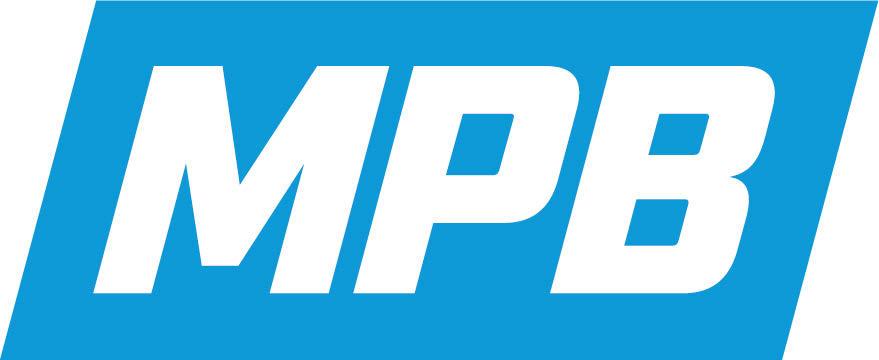
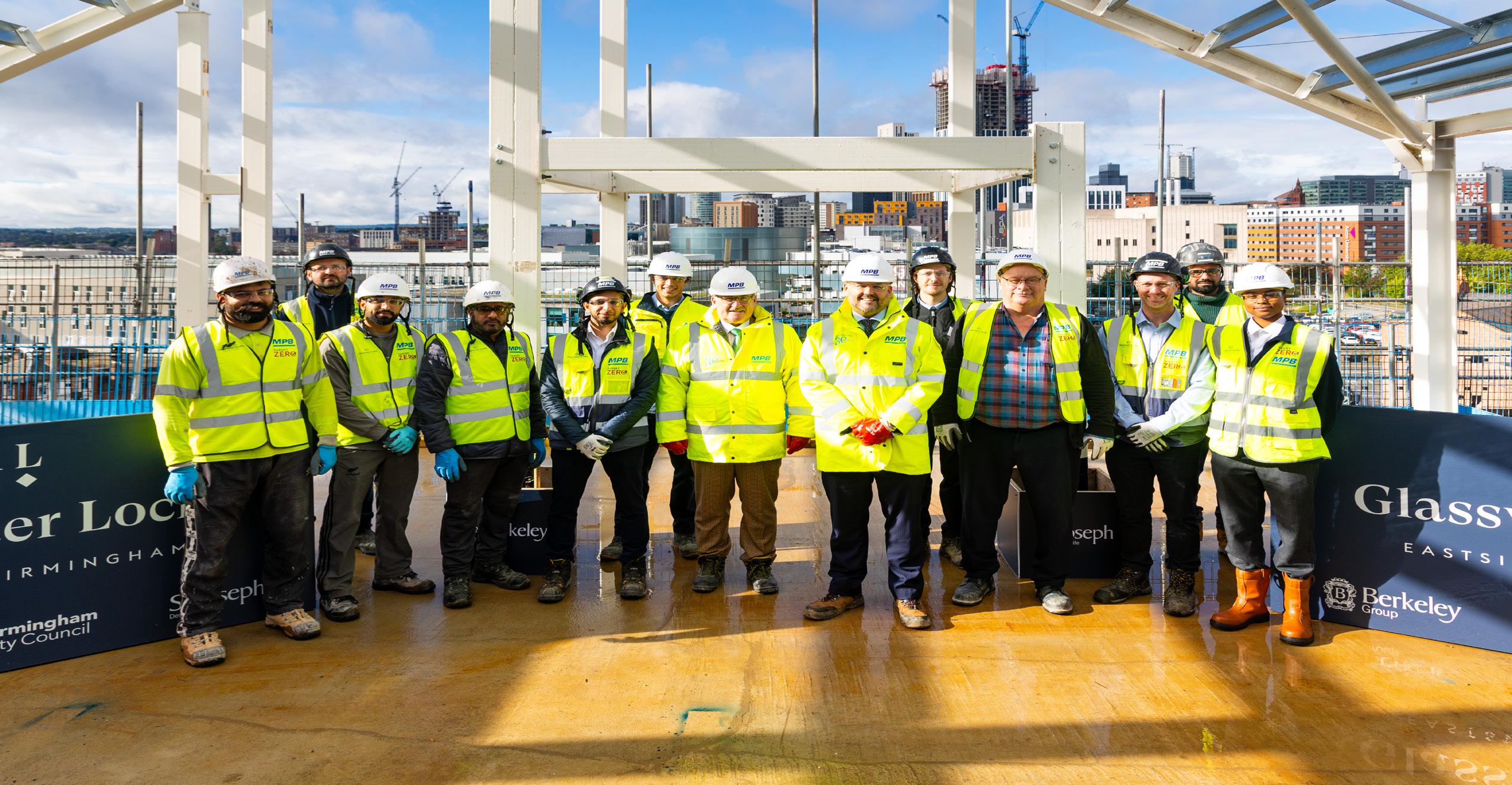
Founded by Michael Boyle in 1987 MPB is one of the UK Top 10 Concrete Frame Contractors, growing stronger year on year with turnover in excess of £150Million. Experienced in delivering intergrated construction solutions to Commercial, Residential ,Education, Rail & HS2 projects to programme, sustainably, Safely and to the highest quality standards, with competitive financial outcomes.
